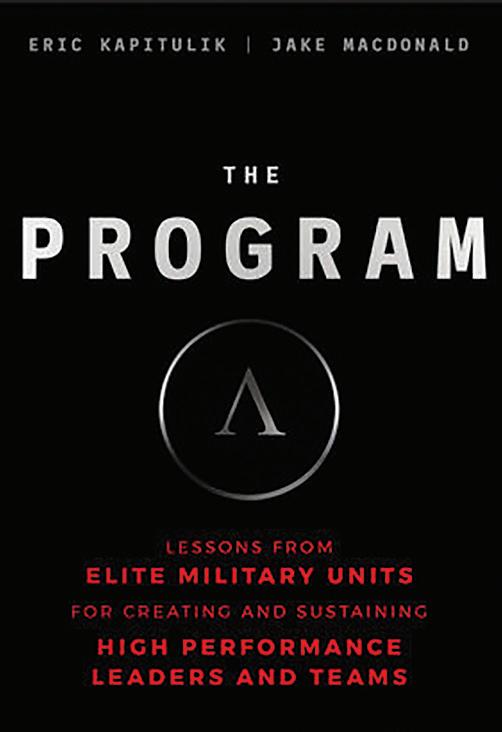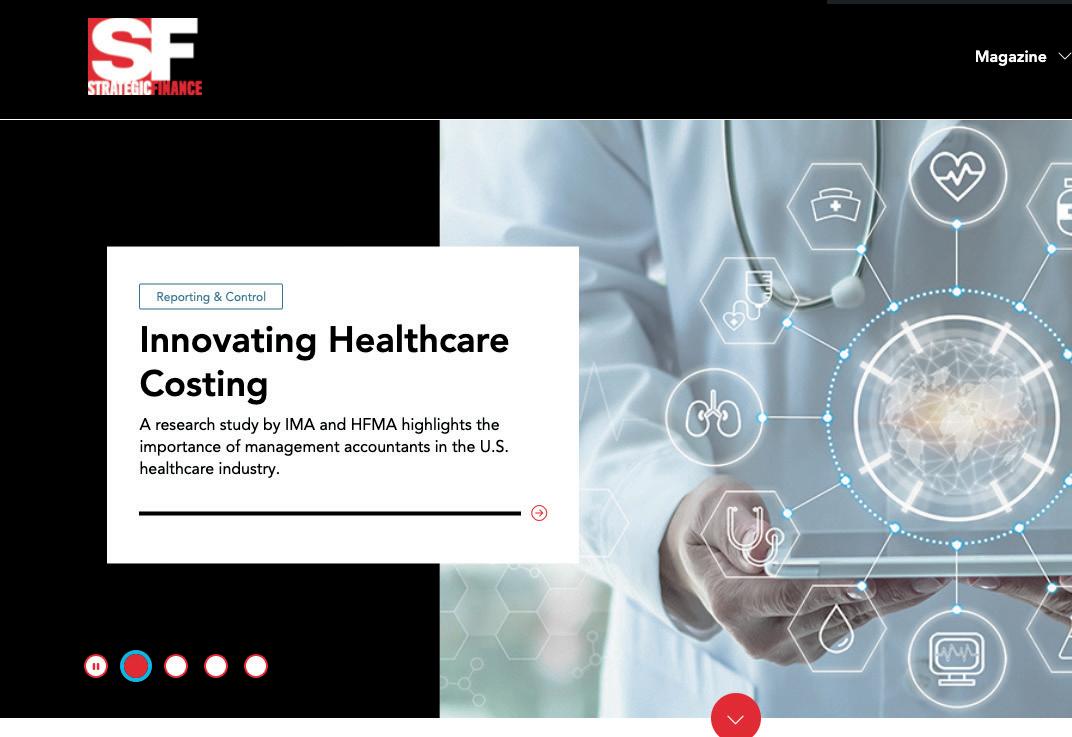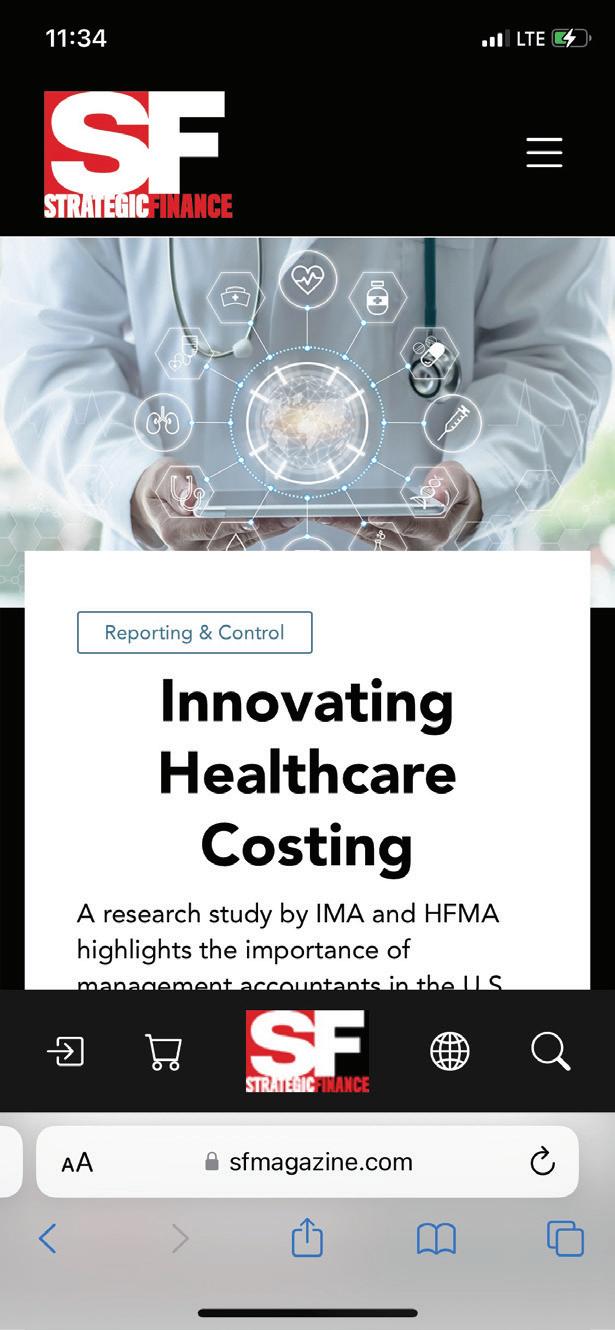










The CFO and finance team are well positioned to mitigate the prolonged supply chain disruptions that have challenged cash flow and profitability.
26/ 34/ 40/ 48/
COVER STORY By combining data analytics and business insights, CFOs can act as partners and catalysts in helping to overcome supply chain challenges.
 BY THOMAS G. CANACE, PH.D., CPA; AYAZ JAFFER, CPA; AND PAUL E. JURAS, PH.D., CMA, CSCA, CPA
BY THOMAS G. CANACE, PH.D., CPA; AYAZ JAFFER, CPA; AND PAUL E. JURAS, PH.D., CMA, CSCA, CPA
A survey examines the impact that practices have on organizational success.
BY LU JIAO, PH.D.; KEVIN BAIRD, PH.D., FCPA; AND NURADDEEN ABUBAKAR NUHU, PH.D.The Earned Capital Approach provides a clear and simple solution to a long-standing challenge.
BY MARY HILL, PH.D., CPA; GEORGE W. RUCH, PH.D.; AND RICHARD A. PRICE III, PH.D.Want more out of your accounting and finance career? Then you need to establish a personal brand that best reflects your abilities, values, and ethics. For aspiring professionals, it has become a necessity rather than a nice-to-have.
BY DONALD W. CAUDILL, PH.D., AND PHILIP J. SLATER, CMA


IMA helps you gain in-depth expertise on important issues shaping the finance and accounting profession.
This six-course certificate program provides essential education to finance and accounting professionals that will demystify business sustainability and offer keys to effectively deploying initiatives that comply with evolving ESG requirements.

IMA Member $299 // Nonmember $449 10.8 NASBA CPE
This five-course certificate program provides critical knowledge, skills, and effective practices to help finance and accounting professionals foster a diverse, equitable, and inclusive environment.

IMA Member $149 // Nonmember $249 7.5 NASBA CPE
with each certificate program.
EDITOR-IN-CHIEF CHRISTOPHER DOWSETT, CAE cdowsett@imanet.org
SENIOR EDITOR ELIZABETH KENNEDY ekennedy@imanet.org
SENIOR EDITOR NANCY FASS nfass@imanet.org
FINANCE EDITOR DANIEL BUTCHER daniel.butcher@imanet.org
STAFF WRITER/EDITOR LORI PARKS lori.parks@imanet.org
SENIOR DESIGNER JAMIE BARKER jamie.barker@imanet.org
Bruce R. Neumann, Ph.D. Academic Editor
Ann Dzuranin, Ph.D., CPA Associate Academic Editor
William R. Koprowski, Ph.D., CMA, CFM, CFE, CIA Associate Academic Editor
For more information on the role of the Editorial Advisory Board and a complete list of reviewers, visit sfmag.link/reviewers
The R.W. Walker Company, Inc. mike@rwwcompany.com (925) 648-3101
FOR REPRINT INFORMATION, CONTACT: sfmag@imanet.org
FOR PERMISSION TO MAKE 1- 50 COPIES OF ARTICLES, CONTACT: Copyright Clearance Center, www.copyright.com
Strategic Finance® is indexed in the Accounting and Tax Index by ProQuest at www.il.proquest.com
Except as otherwise noted, the copyright has been transferred to IMA® for all items appearing in this magazine. For those items for which the copyright has not been transferred, permission to reproduce must be obtained directly from the author or from the person or organization given at the end of the article.
Views expressed herein are authors’ and do not represent IMA policy unless so stated. Publication of paid advertising and new product and service information does not constitute an endorsement by IMA of the advertiser or the product or service.
Strategic Finance® (ISSN 1524-833X/USPS 327-160) Vol. 10 4, No. 12, June 202 3. Copyright © 202 3 by IMA. Published monthly by the Institute of Management Ac coun tants, 10 Paragon Drive, Suite 1, Montvale, NJ 07645. Phone: (201) 573-9000. Email: sfmag@imanet.org
MEMBER SUBSCRIPTION PRICE: $48 (included in dues, nondeductible); student members, $25 (included in dues, nondeductible).
www.sfmag.link/sustainability
A monthly blog covering ESG strategy, reporting, and disclosure topics such as:

● Accountants’ role in sustainability initiatives








● Success stories of companies that prioritize sustainability/ESG
● Insights on decision-useful nonfinancial metrics and data
PEOPLE HAVE KNOWN for a long time that AI tools are incredibly relevant for our profession, but lately we’ve been hearing about some new technologies that are significantly changing business, academia, science, and potentially every aspect of life.
The key to getting the most out of both ChatGPT and Auto-GPT, however, is the ability to pose the proper prompts. Without this, you’re facing the classic “garbage in, garbage out” problem. The same is true for many areas of life: Asking the right questions is the best way to get at the heart of a difficult decision or navigate the clutter of a multitude of choices. In my own experience, I’ve also found asking questions is often the simplest and most effective way of learning.
Gwen van Berne, CMA, is director of finance and risk at Oikocredit and Chair of the IMA Global Board of Directors. She’s also a member of IMA’s Amsterdam Chapter. You can reach Gwen at gwen.vanberne @imanet.org or follow her on LinkedIn at bit.ly/3LVeRGM

Recently, I was walking the family dog with a friend who is a well-respected technology expert, and we talked about our ideas and experiences with one of these AI tools, ChatGPT, which has dominated the news lately. ChatGPT is a chatbot that generates human-like responses to various prompts, and we had some fun testing the output to several heavy-content questions and seeing how ChatGPT dealt with these and our follow-up questions.
ChatGPT has already become an enormous game changer, but when my friend told me about Auto-GPT, which automates task-oriented conversations and provides structured and specific responses, all without requiring human intervention, I was really blown away and confronted with a mind-boggling and pretty hard truth. My friend showed me how the agents from Auto-GPT worked with an assignment he gave, and he told me about a variety of new products and services now possible through this tool. Seeing the output and independent thinking and acting abilities of Auto-GPT gave me a very concrete picture of the potential AI has to change the way we work and our lives in general.
In the world of business, accounting and finance professionals can gain influence and advancement opportunities if we practice and perfect the art of asking the right questions. Having excellent communication and interpersonal skills helps as well, as does being cognizant of the needs of those who have a stake in the questions posed and answers given. On this subject, I was inspired by a recent Het Financieele Dagblad interview (bit.ly/42c3a7q) with Ellen Garvey-Das of Egon Zehnder, where she explained that modern leaders need to be able to listen to their stakeholders. In my view, active listening requires being open-minded, using all your senses, paying attention to verbal and nonverbal clues, and refraining from judgment. If you combine these listening skills with your ability to ask the right questions while also trusting your value system, you’ll be able to lead in the world of tomorrow.
With these words, I conclude my final Perspectives column as your IMA Chair. It has truly been an honor to serve as IMA’s volunteer leader this past year, and I hope to contribute to the profession in new ways once my term of service is done. I will always be grateful for this opportunity. Thank you. SF
BERNE, CMA
«It has truly been an honor to SERVE AS IMA’S VOLUNTEER LEADER this past year.»

IMA members became CMAs between April 1 and April 30, 2023.
The names of all the new CMAs can be found on the Strategic Finance website at sfmagazine.com/issue
/june-2023 .
For more information on CMA certification, visit www.imanet.org /cma-certification .
Mentoring, toughness, and teamwork can improve performance in the finance function.
Eric Kapitulik and Jake MacDonald are former U.S. Marines who adapted their special forces training into a book called The Program: Lessons from Elite Military Units for Creating and Sustaining High Performance Leaders and Teams, as well as a live seminar. The program is intended to help organizations build stronger teams and improve leadership by explaining concepts through the lens of team-based physical disciplines as well as military training programs.

They also utilize analogies from the world of sports, corporations, and even schools. Kapitulik and MacDonald explain takeaways from their experiences running a military training program, climbing Mount Everest, and overcoming other challenges, often stepping well out of their comfort zone to accomplish their goals.
Kapitulik and MacDonald believe that talent is common, but discipline and a framework to accomplish team missions are often lacking. Teams need to learn and adhere to core values of their own choosing, and the authors lay out the groundwork for doing so. They also provide information on what it means for colleagues to hold each other accountable.
Although the book stresses the importance of physical and mental toughness, the program entails a significant amount of relationship building and concern for the well-being of others. The authors criticize management styles that create sharp divisions between team members and leadership. Hands-on mentoring and coaching are considered far more suitable for effective team building. There’s no shortage of examples to drive home the points in the book, from the University of Michigan’s basketball team’s infamous time-out disaster to battlefield medicine in a crisis situation.
The Program, especially in the beginning, may bog down a reader with jargon and definitions that can be hard to follow at first glance, and the level of detail with which these concepts are described seems more suited to a live audience than a printed work. Nevertheless, the book is a fascinating read that explains the thought process behind the authors’ philosophy. The advice in The Program could help others succeed in their missions, whether they’re in an elite military unit, the finance function of a company striving to increase business, or a sports team looking for an edge.
Yuliya BaranovskayaIMA® would like to thank and acknowledge the following members, chapters, councils, individuals, and companies who made tax-deductible contributions to IMA’s Annual Giving Campaign designated to the following themes from May 1, 2022, to April 30, 2023:
■ IMA initiatives and its overall Annual Giving Campaign
■ IMA Leadership Academy
■ IMA Memorial Education Fund, Inc. Scholarship
■ IMA Research Foundation
Tax-Deductible Contributions Received from May 1, 2022, to December 31, 2022:
Tax-Deductible Contributions Received in 2022 Designated to IMA initiatives and its overall Annual Giving Campaign
Robert Half
Shauna Aryee
Whitney Allison Glover
Peter J. Dolan, CMA, CSCA, CFM, CPA
Tax-Deductible Contributions Received in 2022 Designated to IMA Leadership Academy
Jason Larue Barrett
Gail S. Sawyer-Walker
Felix A. Telado, CMA, CFM
Anindya Bagchi, CMA, CSCA
Yuqing Zhang, CMA
Jonathan Camacho, CMA
Sameera Vimarshan
Mallawa Arachchige
Don, CMA
Mahmoud Ibrahim Husseini
Mohamed Eltawil, CMA
Suitao Yang, CMA, CPA
Fahim Ashraf, CMA
Daniel F. Cleary, CMA, CPA
Brendon K. Sehorn, CMA, CPA
Wael H. Al Rasheed, CMA, CSCA
Tad C. Miller, CMA, RTRP
Larry F. Core, CMA, CPA
Jerry Stecher
Karvol Karlos Mackey, CMA, CPA, CTP
Catherine B. Long, CMA
Richard T. Brady, CMA, CGFM
John B. Dever, CPA
Thomas G. White, CMA
Susumu Sakiyama
Abdulaziz Ashur Said, CMA, CFM, CPA, CFA
Kareem Nuseibeh
Jacklynne Fair Sy Cabigunda, CMA
Jamil I. El Halabi, CMA, CFM, CPA, CFE
Martha C. Gibson, CMA
Lisa M. Coyle, CMA
Cherryl Almazan Tolentino, CMA
Amin Bogari, CMA
Esam Ziad Taan
Elizabeth Helbig
Nanda Senathi, CMA, CPA
Gerald C. Reiss, CMA, CPA
Nancy C. McCleary, CPA
Krishna Prasad, CMA
Katherine Sheena Tugade, CMA
Sandra D. Giani-Kipnes, CMA, CPA
Troy K. Senter, CMA, CPA
Derek McSpadden, CMA
Scott G. Davis, CPA
Sean M. Phillips, CMA, CFM, CPA
Rodora Medenilla Lizardo, CMA, CPA
Ntshana Jim Matsemela Jr.
Faizan Ashraf, CMA
Kaneez Zainab Jamal
John C. Macaulay, CMA
John E. Hetrick, CMA
Marc L. Paper, CMA, CPA
Mazen I. Al Sadi, CMA
Sherin Joseph
Yin Chen Hsu, CMA
Raymond M. Tokarz, CMA
Shyama P. Banerjee, CMA
■ IMA Stuart Cameron McLeod Society Scholarship
■ IMA Student Leadership Conference
■ IMA Century Student Scholarship Fund
Tomas Raymond Martinez, CMA
Anne Leighty
Lisa S. Pendergrass, CMA, CPA
Louise E. Crider
Fadi Sami Al Amer, CMA, CSCA
Marina Capobianco, CMA
Ahmad Almaie Sr., CDP, PMP
J. Stephen McNally, CMA, CPA
Tracy L. Taylor
Tax-Deductible Contributions Received in 2022 Designated to IMA
Memorial Education Fund, Inc. Scholarship
Eric D. Weedon
Philip A. Zammataro Jr., CPA
Jason Larue Barrett
Shauna Aryee
James E. Duffie, CMA, CPA
John J. Cifu, CMA, CFM
Cynthia L. Preston, CMA, CFM
Anindya Bagchi, CMA, CSCA
Jonathan Camacho, CMA
Daniel Christopher Miller
Prakash Chandra Sharma, CMA
Essam E.M. Moustafa Hussein
Henry A. Rueden, CMA, CPA
Loutfi K. Echhade, CMA, CFM, CPA, CFE, CIA, CISA, CBM
Monica A. Zillman, CMA
Yuen-Ching Choi, CMA
Steven F. Mahns, CMA, CPA
Cynthia J. Khanlarian, CMA, CPA
Brad Ledford, CMA, CPA
Stephen E. Platt, CMA
Daniel F. Cleary, CMA, CPA
Wael H. Al Rasheed, CMA, CSCA
Emma Cole
Karvol Karlos Mackey, CMA, CPA, CTP
Catherine B. Long, CMA
Charlie J. L’Heureux, CMA
Richard T. Brady, CMA, CGFM
Sally K. Hagen, CMA
Howard B. Allenberg, CPA
Rodger L. Muschett
John B. Dever, CPA
Catherine Weber, CMA, CPA
Kenneth Alfred Sam, CMA
Owen King
Abdulaziz Ashur Said, CMA, CFM, CPA, CFA
Kareem Nuseibeh
Jacklynne Fair Sy Cabigunda, CMA
Melissa A. Howsare
Steven E. Shamrock
Constance D. Larsen, CMA, CFM, CPA
Daniel F. Viele, CMA, CPA
Lee H. Nicholas, CMA, CPA
Timothy D. Cairney
Patricia Siegfried
Cherryl Almazan Tolentino, CMA
Mostafa Ahmed Tawfik, CMA
Veronica Alexander
Amazon Smile
Douglas E. Ziegenfuss, CPA, CGFM
Nick Morganti, CMA, CFM
Michael F. Ruff, CMA, CPA
Esam Ziad Taan
Ratheesh Avaronnan, CMA
Nanda Senathi, CMA, CPA
Gerald C. Reiss, CMA, CPA
John R. Myles
Bruce E. Willman, CMA, CFM
Krishna Prasad, CMA
Huggins Phiri, CMA
Jose E. Munoz Jr.
Mark H. Komatsu-Yonezawa
Katherine Sheena Tugade, CMA
Sandra D. Giani-Kipnes, CMA, CPA
Troy K. Senter, CMA, CPA
Derek McSpadden, CMA
William M. Watts, CMA
Scott G. Davis, CPA
Joseph M. Hargadon, CMA, CPA
Bruce A. York, CMA
Pemberton Smith, CMA, CFM
Sean M. Phillips, CMA, CFM, CPA
Michael F. Monahan
David J. Barrett, CMA
Sinan Alpozer, CMA
James D. Beck, CPA
Ntshana Jim Matsemela Jr.
Victoria Abdurashitova, CMA
Faizan Ashraf, CMA
Kaneez Zainab Jamal
Shirley J. Daniel
John E. Hetrick, CMA
Tufail Potrick, CMA
James A. Rimmel II
Sherin Joseph
Judson Buchan, CMA
Kristine K. Parsons, CMA, CFM
Tomas Raymond Martinez, CMA
Robert D. Brew, CPA
Lisa S. Pendergrass, CMA, CPA
Glenn C. Campbell, CMA
Megan J.F. Will, CMA
Kenneth M. Ashford
Louise E. Crider
Ahmad Almaie Sr., CDP, PMP
Peter J. Dolan, CMA, CSCA, CFM, CPA
Frederick E. Schea, CMA, CSCA, CFM, CPA
Christopher E. McCoy, CMA
Thomas Lenin, CMA, CPA, CITP, PMP Kathy Williams
Tax-Deductible Contributions Received in 2022 Designated to IMA Research Foundation
Cynthia L. Preston, CMA, CFM
Emma Cole
Catherine Weber, CMA, CPA
Lee H. Nicholas, CMA, CPA
Ahmed Elsyed Hazza
Veronica Alexander
Michael F. Ruff, CMA, CPA
Mark H. Komatsu-Yonezawa
Shirley J. Daniel
Taylor & Francis Group LLC
Peter J. Dolan, CMA, CSCA, CFM, CPA
Tax-Deductible Contributions Received in 2022
Designated to IMA Stuart Cameron McLeod Society Scholarship
Loutfi K. Echhade, CMA, CFM, CPA, CFE, CIA, CISA, CBM
Edward J. McCracken
Donald F. Killion, CMA
Mary Ann F. Barker, CMA, EA
John C. Macaulay, CMA
James R. Romesberg
Evan Scarbrough, CPA
William R. Smith
Tax-Deductible Contributions Received in 2022
Designated to IMA Student Leadership Conference
Eric D. Weedon
Rollin D. Brewster, CMA
Felix Affoh Bannerman
Edward Marcelino
Erasmus
Shauna Aryee
Anindya Bagchi, CMA, CSCA
Jonathan Camacho, CMA
Loutfi K. Echhade, CMA, CFM, CPA, CFE, CIA, CISA, CBM
Monica A. Zillman, CMA
Bryan D. Barr, CMA
Daniel F. Cleary, CMA, CPA
Stephen P. Donahue, CMA, CPA
Manjunath Devaru Hegde
Karvol Karlos Mackey, CMA, CPA, CTP
Catherine B. Long, CMA
Richard T. Brady, CMA, CGFM
John B. Dever, CPA
Andreas Udbye
Thomas G. White, CMA
Srinivasan Krishnasawamy, CMA, ACA
Brian D. Edwards, CMA, CPA
Xiaohong Huang, CMA
Abdulaziz Ashur Said, CMA, CFM, CPA, CFA
Kareem Nuseibeh
Jacklynne Fair Sy Cabigunda, CMA
Michelson Pierce Kohls, CMA, CPA
Daniel F. Viele, CMA, CPA
Cherryl Almazan Tolentino, CMA
Noman U. Haq, CMA, CFM
Veronica Alexander
Esam Ziad Taan
Patrick A. Haggerty, CMA
Nicole J. Olesen, CMA, CPA
Bruce E. Willman, CMA, CFM
Kristi Anne Kemple
Mark H. Komatsu-Yonezawa
Katherine Sheena Tugade, CMA
Troy K. Senter, CMA, CPA
Anthony P. Pencek, CPA
Mark C. Woodbury, CMA
Derek McSpadden, CMA
Joseph J. Mesquita
Scott G. Davis, CPA
Joseph M. Hargadon, CMA, CPA
Sean M. Phillips, CMA, CFM, CPA
Ntshana Jim Matsemela Jr.
Faizan Ashraf, CMA
Kaneez Zainab Jamal
John C. Macaulay, CMA
Shirley J. Daniel
John E. Hetrick, CMA
Anthony N. Caspio, CMA
Hadassah Baum, CMA, CPA, CAE
Carlos Eriel JimenezAngueira
Kristine K. Parsons, CMA, CFM
Anand Satchit
Jammalamadaka, CMA, FCMA (India)
Tomas Raymond Martinez, CMA
Lisa S. Pendergrass, CMA, CPA
Joseph D. Nycum
Megan J.F. Will, CMA
Hassan Abdulrahman A. AlShahrani, CPA
Louise E. Crider
Ahmad Almaie Sr., CDP, PMP
Christopher E. McCoy, CMA
Raymond H. Peterson
Thomas Lenin, CMA, CPA, CITP, PMP
Tax-Deductible Contributions Received in 2022
Designated to IMA Century Student Scholarship Fund
John C. Macaulay, CMA
Daniel Christopher Miller
Tax-Deductible Contributions Received from January 1, 2023, to April 30, 2023:
Tax-Deductible Contributions Received in 2023 Designated to IMA initiatives and its overall Annual Giving Campaign
Zach James
Jim Asperger
Tax-Deductible Contributions Received in 2023 Designated to IMA Leadership Academy
John T. Powell, CPA
Sharon N. Griffith, CMA
Joseph Lubanski, CMA
George S. Maniatty Jr.
Rajkumar Patra, CMA
Beaatrice QuintanillaAbercrombie
Stefano Bastianetto
Debra Crutchfield
Kelly M. Anderson, CMA, CPA
Renata T. Serban, CMA, CPA
Gloria Gasgonia
Robert Levy
Nargiza Rakhmonova
Premchand Muraleedharan, CMA
Carlo Martin Vallone
Tapas Ranjan Swain, CMA, PMP
Haitham Essa, CMA
Elizabeth Gibbar, CMA, CPA
Presanna Narayan
Hussein Kh. M. Shehadeh, CMA, CSCA, CPA
Clarence Edward McFadden II
Rohidas Nagappa Moger
Larry Dodd
Sridhar Sethuraman, CMA, ACMA (India)
Srikrishna Mankal, CMA
Sara Farid, CMA
Robert M. Tobben, CPA
Kiran Krishna Kumar, CMA, CSCA
Nathan L. Malone, CMA
Arthur E. Campbell, CMA, CPA
Philip A. Zammataro Jr., CPA
Brandon Pfeffer, CMA
Jacob Wolstenholme
Dmytro Ivchenko, CMA
Khalifa Ahmed Almansouri, CMA
Ronald D. DiMattia, CMA, CPA
Lynette Pebernat, CMA, CFM, CPA, CITP
Tax-Deductible Contributions Received in 2023
Designated to IMA Memorial Education Fund, Inc.
Scholarship
Louise P. Wong
Robert A. Gunter, CMA
Joseph Lubanski, CMA
Nicos C. Kacoullis
Alma Kuttner
George S. Maniatty Jr.
Gloria A. McCartney, CMA, CPA, CISA
Hazem Khalil El Haj Khalil, CMA
Rickey Coslett, CMA
Harshi Motwani
Ann C. Dzuranin, CPA
Richard Hoyt Reginald
Brooks W. Kelley, CMA
Kelly M. Anderson, CMA, CPA
Beverley A. Brooks, CPA
Terri A. Chepregi, CMA, CPA
Edward H. Hodge, CMA
Tawanda Jera, CMA, CSCA
Gloria Gasgonia
Premchand Muraleedharan, CMA
Syon Niyogi, CMA
Jack L. Winstead, CPA, CISA
Barry J. Nathan, CMA
Elizabeth Gibbar, CMA, CPA
Erwin Melger, CMA
Dinesh Pandurang Raorane, CMA, CSCA
Joe Seltz, CMA, CPA, CIA, CFE
Hussein Kh. M. Shehadeh, CMA, CSCA, CPA
Christoph Dopf, CMA
Larry Dodd
Viktor Lavrenyuk, CMA
Sunil S. Deshmukh, CMA
Srikrishna Mankal, CMA
Sara Farid, CMA
Kimberly Kemp Brown
Robert H. Zaleski, CMA
Ee Oh
Robert M. Tobben, CPA
Kiran Krishna Kumar, CMA, CSCA
Nathan L. Malone, CMA
Thomas A. Rubin, CMA, CFM, CPA
William W.H. Tam, CMA
Arthur E. Campbell, CMA, CPA
Philip A. Zammataro Jr., CPA
Edward J. Furticella, CPA
Brandon Pfeffer, CMA
Jeremy A. Jenkins, CMA, CPA
Charles R. Wright, CMA, CPA
Jacob Wolstenholme
Ibrahim Omar A. Aldawsari
Hsiu Hui Wang, CMA
Dmytro Ivchenko, CMA
Khalifa Ahmed Almansouri, CMA
Varghese Kaleekal Parambil Mathew, CMA
Jaypal Jain, CMA
Ronald D. DiMattia, CMA, CPA
Loutfi K. Echhade, CMA, CFM, CPA, CFE, CIA, CISA, CBM
Surya Narayana Murthy Dantu, CMA
Tax-Deductible Contributions Received in 2023 Designated to IMA Research Foundation
Ann C. Dzuranin, CPA
William H. Black, CMA, CPA, CFE, CVA, ABV
Jack L. Winstead, CPA, CISA
Cynthia L. Preston, CMA, CFM
Jaypal Jain, CMA
Paul E. Juras, CMA, CSCA, CPA
Tax-Deductible Contributions Received in 2023 Designated to IMA Stuart Cameron McLeod Society Scholarship
Marcia M. Vinci
Robert A. Gunter, CMA
Brooks W. Kelley, CMA
Beverley A. Brooks, CPA
Il Woon Kim
David W. Skora, CMA, CSCA, CFM
Loutfi K. Echhade, CMA, CFM, CPA, CFE, CIA, CISA, CBM
Lynette Pebernat, CMA, CFM, CPA, CITP
Tax-Deductible Contributions Received in 2023 Designated to IMA Student Leadership Conference
Robert A. Gunter, CMA
Sharon N. Griffith, CMA
George S. Maniatty Jr.
Shin Won Kang, CMA
Bruce W. Runyan, CMA
Ann C. Dzuranin, CPA
Philip Modayil Ninan, CMA
Ruth A. Morgan-Brown, CMA
Kelly M. Anderson, CMA, CPA
Beverley A. Brooks, CPA
Renata T. Serban, CMA, CPA
Robert Levy
Premchand Muraleedharan, CMA
Christine Palmer Andrews
Jack L. Winstead, CPA, CISA
Elizabeth Gibbar, CMA, CPA
Lorna E. Hardin, CMA, CPA
Dinesh Pandurang Raorane, CMA, CSCA
Joe Seltz, CMA, CPA, CIA, CFE
Hussein Kh. M. Shehadeh, CMA, CSCA, CPA
Larry Dodd
Melinda Kay Radford
Christina Palestine, CMA, CPA
Sridhar Sethuraman, CMA, ACMA (India)
Robert M. Tobben, CPA
Nathan L. Malone, CMA
Richard G. Nadalini, CMA
Yu Cheng, CMA
Arthur E. Campbell, CMA, CPA
Edward J. Furticella, CPA
David Perrins, CMA
Brandon Pfeffer, CMA
Jacob Wolstenholme
Virginia D. White, CMA, CSCA
Cynthia L. Preston, CMA, CFM
Dmytro Ivchenko, CMA
Khalifa Ahmed Almansouri, CMA
Joan A. Cox, CMA, CPA
Paul E. Juras, CMA, CSCA, CPA
Ronald D. DiMattia, CMA, CPA
Loutfi K. Echhade, CMA, CFM, CPA, CFE, CIA, CISA, CBM
Tax-Deductible Contributions Received in 2023 Designated to IMA Century Student Scholarship Fund
Ronald D. Luther, CMA, CPA
D. Robert Okopny, CMA, CFE, CIA
Nashville Chapter
Paul E. Juras, CMA, CSCA, CPA
Robert Half


SF articles are in a digital format that’s easy to read, share, and print. Access SF using your mobile device. You can search content based on the topic of your choice. Read our monthly blogs, including SF Sustainability and IMA Moments.


While ethics is often thought about at an individual level, it’s crucial to consider companies’ impact on societal issues.
BY DANIEL BUTCHERWHILE NO ONE EXPECTS management accounting and finance professionals to be able to fix systemic ethical issues on their own, stakeholders—including customers, employees, shareholders, and society—do expect business leaders to address challenges such as workplace inequality to the extent that they’re able. The Conference Board, a member-driven, nonpartisan, not-for-profit think tank, regularly convenes senior executives across industry verticals in virtual and in-person conferences, asking their opinions on ethics and corporate citizenship and researching the steps the attendees are taking to drive lasting change in their own organizations and communities to work toward a more just and civil society.
Chuck Mitchell, executive director of content quality at the Conference Board, argues that leaders have both a moral obligation and a business imperative to address environmental, social, and governance (ESG)—as well as economic—threats to achieve a sustainable business model providing prosperity for all. Objectives include opening equal opportunities in education, workplace advancement, upward mobility, and wealth creation in the context of benefiting the business.
Mitchell stresses that social justice and corporate citizenship aren’t about altruism or being good for goodness’s sake. Finance leaders can help to make the business case for it to be driven from the top down as part of the organization’s long-term strategic plans.
“There’s such an acute awareness of issues around civility, justice, equality, and equal opportunity and a change in the attitude of a workforce that’s looking for businesses to lead in these areas,” Mitchell says. “Even though there’s that realization that now it’s part of corporations’ responsibility, the first issue that one has to overcome is that there’s still a perception out there that there’s a trade-off, sacrificing profit for social good, and that simply isn’t the case—there’s enough data out there to show that you can do both effectively, and, in fact, if you take care of the community, the business, in some instances, will take care of itself.”
Conference Board research shows that an overwhelming percentage of employees want their organizations to be engaged and to speak out on social issues, especially around gender and equal pay, as well as, to a lesser extent, race.
“So if you’re head of the finance function or if you’re managing people, the most important thing is to find out what issues are on [employees’] minds and that they feel the company can do more, both internally and externally, to address issues of equal opportunity,” Mitchell says. “It’s really about taking care of the overall well-being of your staff, listening, and getting input from your team members and those that you manage, being very open and transparent and trying to understand what issues they have [top of mind].”
After listening to the issues that matter to employees and other stakeholders, a strong leader can help the finance function to lead by example in being advocates for ethics and corporate citizenship. Mitchell suggests that leaders can begin by recognizing that there’s probably been inequality of opportunity within the organization and across the profession for a long time. Now finance leaders and hiring managers need to address it.
“If you can start…building equal opportunity within your own function, then you don’t have to wait for the headquarters to lead,” Mitchell says. “Individual leaders within their function can take that
responsibility, and it really starts with the recruitment process, making sure that you’re looking at a diverse slate of candidates and that equal opportunities are given for internal promotion opportunities from within, and that the career needs of minority staff are being met through mentoring.
“It’s not going to be solved all at once, but you can start with small steps, even within your function, and it really starts with making sure that the recruitment pipeline is diverse—you have to have a diverse slate of candidates for each open position, and the same goes for internal promotions,” Mitchell says.
“On an individual basis, there’s a lot that a CFO, the head of a function, and managers can do with their own teams, and as long as those conversations are open, transparent, and honest, it’s going to work.”
Mitchell says that becoming a socially responsible company requires thoughtful discussions among leadership during the strategic planning process informed by both financial and nonfinancial ESG metrics. After leaders agree to a plan for which social issues to address and how to do so, the next step is internal communications to get employee buy-in, establishing a mission and sense of purpose across the organization.
“You don’t just say, ‘We’re going to be socially responsible’ and then do it piecemeal,” Mitchell says. “It has to be a strategy that’s embedded across the enterprise, from the board and the C-suite to middle management and individual contributors.”
For clarification of how the IMA Statement of Ethical Professional Practice applies to your ethical dilemma, contact the IMA Ethics Helpline.
In the U.S. or Canada, dial (800) 245-1383. In other countries, dial the AT&T USA Direct Access Number from www.business.att.com /collateral/access.html, then the above number.
The IMA Helpline is designed to provide clarification of provisions in the IMA Statement of Ethical Professional Practice, which contains suggestions on how to resolve ethical conflicts. The helpline cannot be considered a hotline to report specific suspected ethical violations.
The Conference Board is careful to emphasize that prioritizing social justice and corporate citizenship isn’t just the ethical course of action but it’s also in organizations’ best interests. More investors are now seeing it as a road to profitability and long-term sustainability, not a separate ethics issue.
Mitchell acknowledges the validity of looking at these issues through an ethics lens, but it’s hard to separate that view from business imperatives without weakening the sense of urgency or motivation to act. He cites the diversity, equity, and inclusion function, which is still battling the idea that it’s an add-on that’s somehow separate from a company’s core business.
“I get a little bit concerned if you separate social justice issues and put them in an ethics bucket, because the essence of what we see from these CEOs, CFOs, and other conference participants, from our data, they tell us that it’s very much a business decision,” Mitchell says. “Yes, it’s the right thing to do, but it’s all part of doing business—this whole social justice and corporate social responsibility push shouldn’t be a separate vision from the business; it’s part of it, and one has to do the cliché ‘walk the talk’ to preserve and enhance the organization’s reputation.” SF
Daniel Butcher is the finance editor at IMA and staff liaison to IMA’s Committee on Ethics. You can reach him at daniel .butcher@imanet.org
Accountants with a strong business partner mindset might face identity-related challenges when confronted with strict productivity measures.
BY LUKAS GORETZKI AND JAN A. PFISTERMANY PROFESSIONALS ARE challenged to improve their productivity and provide quantitative evidence to manage and make visible their productivity gains. For accountants, this can lead to a dilemma. On the one hand, they try to establish themselves as strategic advisors and partners for business managers. On the other hand, they’re under increasing pressure to perform their tasks in cost-efficient ways.
Company efforts to streamline accounting processes through automation, augmentation, and the elimination of redundant activities often result in the rearrangement of accounting work through outsourcing or the creation of shared service centers—accompanied by a growing demand for accountants to quantitatively prove their productivity.

In this context, we had an opportunity to explore how accountants designed and implemented a new performance measurement system to assess their own productivity, a phenomenon that hadn’t yet been studied in depth. Our study, “The productive accountant as (un-)wanted self: Realizing the ambivalent role of productivity measures in accountants’ identity work” (Critical Perspectives on Accounting, August 4, 2022, bit.ly/3NfMUOl), examined the question: How do accountants experience and respond to increasing productivity pressure and a corresponding measurement regime monitoring their work?
We traced how accountants in a fast-growing multinational technology company faced the challenge of dramatically increasing their productivity and presenting constant improvements through strict measures. At first, the accountants were open to the productivity challenge and willing to demonstrate their performance through the newly developed metrics. Over time, however, they realized that subordinating themselves to those metrics would downgrade what they do and who they are (i.e., their occupational identity).
The accountants in the case company had developed a business partner identity built on a strong sense of strategically performing important and complex expert work that made a significant contribution to management. Their challenging role implied that they often
needed time and flexibility to dive into and solve difficult accounting problems that were relevant for managers (e.g., integrating newly acquired companies or designing complex deals with customers).
The emerging focus on productivity measures, however, meant that processes needed to be streamlined and ideally standardized to be performed in an increasingly cost-efficient way. The company thus experimented with accounting and control tools (e.g., activity-based costing supported by detailed time tracking). To ensure that the new tools could work properly, accountants needed to meticulously track their activities and tag them according to predefined categories.
This conflicted with their understanding of their complex and multifaceted role as business partners, which they felt couldn’t easily be expressed in standardized units. To deal with the productivity challenge, accountants engaged increasingly in activities aimed at innovating their work. Thus, endeavors to standardize their tasks resulted in more nonstandard project work. Although their work increasingly shifted toward process innovation tasks, the new productivity measures focused on capturing routine activities. Paradoxically, the increasing productivity pressure caused by the measurement and shift in the nature of work tasks made productivity measurement more difficult.
Accountants eventually felt increasingly uncomfortable expressing their performance through the new measures. This
discomfort was further intensified by accounting managers’ increased focus on productivity as a key performance indicator. The accountants in the case company eventually started to resist productivity measurement and to champion a more qualitative assessment of their work based on performance narratives.
While productivity measures have potential benefits, our study demonstrated that predominantly relying on them might have problematic consequences for employees. The measures can produce a false sense of clarity and direction for accountants’ performance. Strong reliance on those measures can in this sense create the impression that what counts for an accountant to perform well is to emphasize productivity over other criteria (e.g., internal customer satisfaction).
Also, productivity measures are incomplete representations of accountants’ performance, making the resulting transparency and comparability of those measures problematic. While highlighting specific criteria that are amenable to quantification, productivity measures disregard performance dimensions that accountants (and managers) might consider more important for the business partner role but are potentially more difficult to measure. Over time, a strict focus on productivity measures thus creates the risk that those performance dimensions lose relevance.
Senior practitioners (e.g., CFOs or accounting managers) must be cautious when designing performance measures for accountants and consider the developments that the accounting occupation has undergone in the last several decades. The accounting profession has worked hard to establish its members as professional knowledge workers who deal with complex strategic and operational issues in organizations.
Drawing solely on productivity measures might not adequately consider those developments and present accountants with challenges that can render fragile their identity as business partners. This can eventually lead to frustration or resistance against performance measures, as the study shows.
More broadly, the findings of the study have implications for the relationship between the design and use of productivity measures and any occupational identity. As the case study demonstrates, productivity measures are unable to capture the full complexity and variety of tasks. The ability to quantify performance might thus come at the expense of unquantifiable elements that employees consider as meaningful or prestigious work and that motivate them the most.
Even more, performance measurement might crowd out employees’ aspirations to perform such meaningful work. Aligned with the phrase “what you measure is what you get,” the focus of employees might turn to the measurable activities and move away from those
strategically and operationally important tasks that aren’t well captured by the measurement system.
Senior managers should keep employees’ occupational aspirations in mind and remain alert to the limits of measurement. This means creating a performance culture where productivity measures aren’t blindly followed as pure and objective truth but where everyone is encouraged to remain critical of what the measures track, incentivize, and motivate. This is important to avoid dysfunctional countereffects of productivity measures, like employees’ demotivation and perception of being unvalued, unfairly judged, or hindered in their occupational aspirations.
Ultimately, productivity measures are a tool that can’t be taken at face value but rather as input for discussion and reflection. Otherwise, important productivity-enhancing activities might be diminished, and productivity measures can paradoxically create a reverse effect of what they’re intended to do. SF
Lukas Goretzki is professor of management accounting and control in the Department of Accounting at Stockholm School of Economics. He can be reached at lukas.goretzki @hhs.se
Jan A. Pfister is associate professor of management accounting at Turku School of Economics and an affiliated researcher at the House of Innovation and the Mistra Center for Sustainable Markets at Stockholm School of Economics. Jan can be reached at jan .pfister@utu.fi
Affordable automation tools and effective implementation strategies can strengthen duty separation.
BY WASSIA KAMON, CMA, CPAMOST SMALL BUSINESSES STRUGGLE TO maintain adequate separation of duties in their accounting functions due to their limited staff. Often only one or two people handle all the accounting and treasury tasks of the business, with little to no oversight. This leads to situations where the same person could commit and conceal fraud or make significant errors that go undetected. Fortunately, affordable automation tools are now available that provide small businesses with solutions to mitigate such concerns.
The separation of duties (SoD) principle is an internal control that recommends that the bookkeeping, custody, and authorization aspects of a business transaction be handled by different staff members. But this involves a minimum of three employees working in an accounting department of any given business, which often isn’t realistic for smaller companies.
Small businesses are characterized by tight budgets, lean operations, and limited resources. Therefore, internal controls are often an afterthought, as employees wear multiple hats to get things done. The challenges of hiring and retaining employees since the COVID-19 pandemic are making it worse.
Without proper checks and balances, mistakes can easily go unnoticed, and dishonest employees may take advantage of the situation. As a result, the same person can:

1. Set up a new vendor in the accounting system (including, name, address, or payment information).
2. Record the invoice charges and description.
3. Issue and authorize payment.
4. Reconcile bank statements.
This clearly goes against SoD principles, making smaller companies more susceptible to fraud. According to the Association of Certified Fraud Examiners (ACFE), the lack of internal controls, such as SoD, accounts for one
third of fraud committed. Small businesses are the most vulnerable, with 43% lacking proper internal controls and 60% never recovering their losses from fraud (see the ACFE’s 2020 Report to the Nations, bit.ly/3iRQldN).
With the help of technology, small businesses can now better mitigate these risks. Accounting automation tools now provide built-in checks, balances, and audit trails at affordable rates for small businesses. Though only one or two people will continue doing the bulk of the accounting functions, business leaders and owners can have greater transaction visibility during the approval and review process of accounting transactions. The following are three automations that can help small businesses mitigate risks associated even without proper SoD and optimize their business processes at the same time.
1. To ensure SoD in the accounts receivable process, the employee creating and sending the customer invoice should be different from the employee collecting and recording the payment for that invoice. Whenever those tasks are handled by only one person, automation software should be implemented.
Accounts receivable automation software streamlines invoicing and payment collection. Invoices can be automatically generated and sent to customers as soon as
the sales process is completed. Due dates and payment reminders are also sent automatically. Payments from customers are matched to the transactions received by the system, with often no manual input needed from accounting staff. System audit trails are available in case auditors or business managers want to review manual overrides.
2. To ensure SoD in the expense reporting process, the employee requesting the expense reimbursement should be different from the employee recording and disbursing the respective payment. Whenever those tasks are handled by only one person, automation software should be implemented.
Expense reporting tools allow all employees to submit their own expense reports directly into the system, along with the appropriate receipt. These expenses are then reviewed by their managers and disbursed to their preferred method of payment, with little to no intervention from accounting staff.
3. Accounts payable automation software works almost the same as expense reporting tools, with the added benefits of validating vendor charges, reducing the risk of duplicate payments, and taking advantage of early payment discounts.
Beyond error and fraud prevention, the insights businesses get after automating routine accounting tasks are phenomenal in terms of transparency and timeliness of relevant information. Invoice exception rate, early payment discounts cap-
tured, and late payments rate and penalties are just a few key performance indicators that can be effectively tracked through an accounts payable automation tool.
Finding the right accounting automation tools is just the first step; the next and equally critical step is implementation. Many underestimate the amount of planning involved at that stage, resulting in missed opportunities to maximize the tools’ benefits. Small businesses with limited IT resources should consider the following tips as they embark on their automation journey.
1. Start with a thorough assessment. Existing processes, workflows, and challenges should be thoroughly assessed before starting any search for process improvement tools. Ideally, the desired SoD should be mapped out among existing staff, managers, and leaders so that the search for an adequate tool is effective.
2. Leverage current resources. If the business already has an accounting system, look for automation solutions that easily integrate with it. For example, well-known small business accounting systems, such as QuickBooks and Sage, have app marketplaces that list several resources that integrate seamlessly with their core accounting systems. These integrations usually allow for automatically syncing data between systems and reducing the
need for repetitive manual entries.
3. Add structure early. Determine the main objectives and budget and establish a well-defined selection process that has questionnaires that all vendors must complete. Having a predefined list of items that should be covered during the demos is also helpful.
4. Recruit adequate help. Consider which efforts will be led in-house vs. external consultants. Hiring temporary staff to assist during implementation is often beneficial.
5. Make room for potential difficulties. Add some buffers to your project timeline and budget. There’s always something that may go wrong when implementing a new tool. But with proper planning, implementing such helpful technology shouldn’t be painful.
Small businesses face many challenges when it comes to maintaining adequate internal controls, particularly regarding SoD, due to limited resources. Automation tools can help mitigate these concerns, providing businesses with affordable options for streamlining their accounting processes. By automating key accounting functions, such as accounts payable, small business owners and accountants can improve their internal controls and reduce the risk of fraud, while saving time and resources. SF
FOR FINANCE PROFESSIONALS TO PERFORM EFFECTIVELY, they have to understand their company’s goals and be able to explain what financial data means for the pursuit of those desired outcomes. Storytelling isn’t just about crafting a compelling narrative from data but also the ability to communicate effectively so that leadership and stakeholders know how much progress the organization is making toward achieving its strategic objectives.
In a conversation with Strategic Finance, Jenn Ryu, CFO of global consulting and staffing firm RGP, and Efrain Rivera, senior VP and CFO of Paychex, a human resources, payroll, and benefits platform provider, talk about the work that accounting and finance professionals perform, starting with analysis and interpretation to get an accurate view of the data, then weaving an insightful, coherent narrative that ties into the organization’s strategic plans and goals.
SF: What are the most important elements of effective storytelling in a professional context?
Ryu: The most important building blocks of effective storytelling are knowing exactly what story you want to convey— the what; understanding your audience so you know the best way to deliver the story—the how; and finally, what you want your audience to take away—the answer to the question “so what?” From a CFO’s perspective, the core components of a good story often originate from financial and operational insights that hinge upon the effective use of data and analytics. Organizations across every industry are investing in finance transformation initiatives to power business momentum and gain valuable insights, from unifying enterprise-wide data to deploying cloud and intelligent automation solutions.
But data and numbers only tell your audience so much on their own. Effective storytelling requires a sound understanding of your audience’s existing perceptions or awareness,

what drives their decision making, and the level of detail that will resonate with them. We must be able to understand the context, adjust the message, and filter out irrelevant information. Context is a vital element of effective storytelling, as dollar impacts and percentage growths may be perceived differently, especially for an emerging service or market.
Rivera: The first important building block of a good story is understanding what the numbers are actually telling you. That information has to be accurate. Secondly, beyond just accuracy, you have to interpret what that information means for the organization.

Let me give an example of how we can have the same top and bottom line, leading to very different conclusions. If you put together a budget that’s correct in totality, meaning the total revenue, total expenses, and net income are correct, then there could still be a lot of variations in between the components of the budget. This is a simple example of the value of variance
analysis. If we don’t understand what’s happening in the components of the budget, then we can miss a lot of what’s going on in the business. As finance professionals, we need to analyze the details at enough depth to truly understand the story that the results and variances are telling.
SF: What are best practices for improving accountants’ ability to communicate effectively and telling a captivating story?
Rivera: The first point that’s really critical is the ability to articulate your story clearly. Every time you tell the story by painting a clearer explanation of results or projections, you’re building and developing your communication skills. Many audiences may not understand all of the financial implications of the data, but you can drive a particular point home by using the right analogies. When you can connect with an audience by painting a picture of something that’s relatable, they can track what you’re saying more easily.
Secondly, you need to rehearse. When I speak onstage, most people think I’m speaking extemporaneously because I have a conversational tone and don’t use notes. In reality, I’ve rehearsed exactly what I want to say seven to 10 times.
Third, it’s important to find some point of connection with the audience. Good, effective speakers like their audience, understand them, and work to build a rapport with them.
If you’re trying to have a conversation with the audience, then make your presentation about them, not you. You need to recede into the background and let the information go to the foreground. People feel affirmed and heard when they’re part of the story, rather than being lectured to.
Ryu: It starts with finding the right narrative for the situation and the audience. Ask yourself what you ultimately want your audience to come away with, determine the right amount of relevant details to provide, and identify the decision points that will lead to agreement. To prioritize
“Many audiences may not understand all of the financial implications of the data, but you can drive a particular point home by using the right analogies. When you can connect with an audience by painting a picture of something that’s relatable, they can track what you’re saying more easily.”
—Efrain Rivera
the information that’s most relevant to your audience, you must consider each individual’s priorities, their backgrounds and knowledge of the material, and the questions they’re likely to ask.
Effective communication and captivating storytelling require lots of preparation and practice. Even more importantly, honest feedback from a trusted mentor or peer will add tremendous value in one’s journey to become an effective communicator.
SF: What aspects of the CFO’s role and responsibilities require storytelling skills or are made more effective by honing those skills?
Ryu: CFOs have always had to be good at translating data into insights and stories that illustrate value, but it’s becoming an even more important skill set as CFOs increasingly operate in a storyteller role. The responsibilities of the CFO have changed greatly over the years— we’ve taken on more of a role as value creators within organizations. Many CFOs are leading transformative initiatives that require an ability to convey to business teams and partners how the transformations fit into company strategies and operational insights in ways that extend beyond traditional financial communications.
The goals of every CFO should be to establish trust, build consensus, and drive strategic decision making. Essential to each of these goals is the ability to boil down insights into a persuasive business narrative while focusing only on what’s most relevant to your audience and what they care about most.
Rivera: As you hone your communication skills, there’s simply no substitute for storytelling consistently. Throughout your week, you can always find opportunities to share your ideas, and your storyboard is the financial information you present.
Most people have an innate ability to be a storyteller but simply don’t practice it enough. For example, I may have an innate musical ability to play guitar, but if I never practice,
then I won’t be able to play a song anyone would want to listen to. If you look [for chances to tell relevant stories], then there are always [growth] opportunities for those who are willing to learn and practice their skills.
SF: How can professionals focus on improving their storytelling to provide a boost to their career?
Ryu: It’s becoming increasingly important for accounting and finance professionals to develop effective communication skills that they can leverage in daily interactions, especially considering the rapid pace of change we’re all experiencing in today’s environment. Professionals at every level and function can benefit from the ability to deliver vital information to their colleagues in a concise and engaging manner. Being great at data analytics can only get you so far in your career if you can’t make the insights known and easy to digest for your executive team and other key stakeholders to drive better decisions and business outcomes.
SF: How can management accounting and finance professionals cultivate their creativity, communication skills, and storytelling abilities in a numbersdriven profession?
Ryu: Accounting and finance professionals can find many resources on this topic in online classes on platforms like LinkedIn and MasterClass, and through professional membership associations such as IMA® [Institute of Management Accountants]. But the best way for accounting and finance professionals to hone these important skills is to gain practical experience by presenting in real-world settings to mentors and colleagues.
Professionals can also develop these skills during everyday interactions, not just important presentations and meetings. Effective storytelling requires you to listen to colleagues, show empathy, take feedback, and constantly adapt your approach as you learn.
Rivera: Although we’re surrounded by numbers, those numbers on their own don’t tell a story for most audiences. They’re simply an input to the story. Our creativity comes in as we determine how to effectively communicate what the numbers are saying in a compelling way that’s meaningful for your organization.
Naturally, we shouldn’t give the exact same presentation to the accounting team as we’d give to the marketing team or the board of directors. When you consider your audience, think about an analogy that fits the [background and knowledge of that] audience. If you aren’t sure, then ask others if your understanding is correct and if your story conveys the desired meaning to the audience.
SF: How important is it for CFOs to acquire data visualization skills and use storytelling to convey the strategy to the organization’s key stakeholders?
Rivera: Data visualization techniques help to reinforce the points being made. There’s an excellent book written by a professor at Yale University, Edward Tufte, called The Visual Display of Quantitative Information. Although it’s about statistics and data, the book reads like an art book with a display of numerical, graphical, and visual displays. Tufte believes that presenters can display numerical information so it can look like art and hammer home the point they’re trying to convey.
It’s critical for each slide to bolster the speaker’s story in a concise way. Some people put up complex graphs with tons of information and think that everyone can follow them, but often the audience can’t.
Think about how you display data and make it simple, whether it’s a line or bar graph or pie chart, and find ways to powerfully support the narrative. As you do this more, you’ll get better at choosing the visual display to drive your point home.
Ryu: Organizations are placing more priority on analyzing their business to gain the insight they need to make strategic decisions about how they can grow, whether that
means expanding their customer base or reevaluating the products and solutions they offer. Investments in [financial planning and analysis (FP&A)] and data analytics tools equip finance teams with the abilities to drill down, consolidate, and visualize data instantaneously, and, as financial leaders, we must be able to use all the tools at our disposal to create an effective narrative. Strong creativity, communication skills, and storytelling abilities ultimately help us draw connections between these finance transformation investments and how the data-driven insights they uncover are impacting opportunities ahead to create long-term value.
SF: How do you decide what medium is most appropriate to convey your story or what multimedia elements can best enhance your presentation?
Ryu: One should always consider their audience when choosing the appropriate medium to convey their story. In general, less is more. Use simple charts, graphs, and images to captivate your audience. Overburdening an audience with too many words or numbers tends to create distractions and diverts their attention
from listening to you to reading the presentation.
Rivera: When deciding what elements to use, leverage whatever you believe clearly conveys the idea you’re trying to present but never show a collection of tiny lines of information. When I first started at Paychex, I used to provide more detailed financials, but I found for most audiences, that level of detail wasn’t important. For most groups that you present to, you’re looking to convey key points to inform their judgment. That’s the art of the discussion: picking the right set of visuals.
For me, I’ve found that transportation visuals resonated since, like a business, vehicles move from one point to another. Find an element like a photo, movie clip, or sound clip that fits your presentation. If it works, then use it.
SF: What are examples of core messages that finance leaders should seek to convey with their stories?
Ryu: The purpose of a good story from a financial leader’s perspective is to create connective tissue between data, the organization’s strategy, and the messages that the

CEO and [the rest of] the C-suite are delivering. Credibility is of the utmost importance for CFOs, and it’s up to us to develop a financial narrative that threads the needle between strategy and performance data, and as a result, leading to calls for action.
Rivera: The story lies within the meaning of a set of financial data. Storytelling for finance professionals isn’t just a compelling narrative woven from data, but also the ability to communicate effectively so the organization knows how it’s tracking against its goals and where it is on the journey. Spending sufficient time on analyzing data creates the ability to craft a compelling narrative.
Likely the most important set of messages we’re trying to convey is where we are currently, where we’re going in the future, and then what challenges and opportunities lie on our journey ahead. If you can state those things clearly to any audience, then you have the making of a good presentation.
SF
“Being great at data analytics can only get you so far in your career if you can’t make the insights known and easy to digest for your executive team and other key stakeholders to drive better decisions and business outcomes.”
—Jenn Ryu

 BY THOMAS G. CANACE, PH.D., CPA; AYAZ JAFFER, CPA; AND PAUL E. JURAS, PH.D., CMA, CSCA, CPA
BY THOMAS G. CANACE, PH.D., CPA; AYAZ JAFFER, CPA; AND PAUL E. JURAS, PH.D., CMA, CSCA, CPA
The CFO and finance team are well positioned to mitigate the prolonged supply chain disruptions that have challenged cash flow and profitability.
ollowing the turbulent years of supply chain disruptions and product shortages during the height of the COVID-19 pandemic, CFOs and companies alike have wondered when the most damaging effects will finally be in their rearview mirror. Yet supply chain problems have continued to intensify, leading to an inability to meet the pent-up customer demand that grew during the pandemic and stymying companies’ revenue growth.
CFOs possess the acumen to serve as valuable partners in the operations of their businesses and are uniquely positioned to act as collaborators and integrators throughout their organizations to counter these challenges with solutions. To enable their business partners to envision the future, they use data analytics to make predictions, gain insights, and guide strategic and tactical decisions throughout the business. Thus, CFOs are partners, catalysts, and visionaries who serve as agents of change—consistent with competencies embodied in the IMA® (Institute of Management Accountants) Management Accounting Competency Framework that finance professionals need to remain relevant in the Digital Age (bit.ly/39UFlc1).
In the face of these recent supply chain issues confronting global trade, CFOs have had no option but to adapt their businesses to yield positive results. What actions are they taking? We spoke with several CFOs to gain insights into the ways they’re addressing supply chain disruptions. There were some recurring themes of the short-term and long-term best practices they’re employing to adjust their supply chains. Table 1 summarizes key insights from these discussions.
First, while CFOs acknowledge the need to bring production closer to their customers, they also know this takes
time. Yet investors and boards of directors expect immediate results. Thus, CFOs are seeking changes to their shipping logistics by renegotiating and expanding contracts with third-party logistics companies as an efficient option for getting product to customers.
Second, while they see supply chain automation as important, they also concede it will take time and investment to build the technology into their operations. In the short term, they’re focusing on integrating more data analytics into their financial analysis so that the finance team can employ the right key performance indicators (KPIs) to help run the supply chain. Yet a common stumbling block in building data analytics capabilities is developing a clear return on investment, so CFOs are keen to point out that their focus must be on providing leading indicators that equip them with the right capabilities to drive strategy through insights and analysis.
Key metrics they cited include the cash conversion cycle, the sea-to-air ratio, the amount of inventory on hand, and distribution and storage costs as a percent of sales. As shown in Figure 1, the cash conversion cycle (CCC) is an integrative tool that combines three metrics to assess a company’s efficiency in selling inventory, collecting receivables, and making payments as a broad indicator of actions needed throughout the business to improve cash flow.
The sea-to-air ratio, which measures the proportion of ocean freight shipments vs. air freight shipments (in dollars and weight), has recently become a focal point in the supply chain. One CFO explained the difficulty companies have in balancing between these two modes of shipment in the current supply chain climate. While the CFO cited a company goal of pushing the U.S. ratio to 50:50, the company currently ships more than 90% by air and the remainder by sea from the production facility to the U.S. distribution centers to maintain inventory to meet customer demand.
Although the high level of air travel is costly, there’s no end in sight due to shipment delays. For instance, the CFO mentioned that sea travel from overseas to New York has increased from a pre-pandemic average of 60 days to
■ Change shipping logistics
■ Integrate data analytics for financial analysis
■ Focus on customer-specific product order needs
■ Balance between JIT and keeping inventory on hand
■ Bring production closer to customers
■ Automate supply chain
■ Move to JIT inventory systems
95 days, while it takes only a few weeks to get product into the United States by air. The CFO further elaborated that “to compete within a tight supply chain, we’ve had to make tough decisions to just do air travel because we need product or else we lose sales to the competitor. We have to carry some inventory.”
Third, CFOs mentioned the need to focus on their major customers and emphasized that supply chain solutions can’t be a one-size-fits-all approach. Thus, they may need to employ different shipping logistics for customers based on their order sizes, order frequency, product sizes, etc. For instance, customers that buy product in bulk at routine intervals may need a shipping logistics plan that’s in close proximity to manufacturing or product-sourcing operations.
Finally, CFOs noted that recent supply chain disruptions have been a clear lesson to balance between Just-in-Time (JIT) inventory and keeping inventory on hand. JIT inventory systems have been the goal in recent decades because they provide the benefit of reduced working capital investments in inventory. Yet companies relying on JIT have been forced to turn away customers as the supply chain became locked up in recent years. In contrast, maintaining inventory stocks ensures there’s enough supply to reduce dependence on the supply chain in the event of material shortages and shipping disruptions. One CFO we spoke with mentioned his company currently wants 90 days of supply on hand to deal with supply chain issues. Of course, this independence comes at the cost of increased working capital investments and reduced cash flow.
How can CFOs manage these consequences? This is where the CCC metric can aid decision making. As slowdowns in inventory turnover, i.e., days inventory outstanding (DIO), adversely affect the company’s ability to turn investment into cash, managing CCC places emphasis on the actions needed throughout the business to improve cash flow. For instance, to keep CCC low, increases in DIO can be
offset by managing the timing of receivables and payables— through supply chain finance arrangements or by negotiating faster collections and prolonged payments.
Recent supply chain disruptions have impacted both the top line and the bottom line—not only have materials shortages slowed production and sales to customers, but rising production and distribution costs have threatened profitability. Thus, challenges in the supply chain affect manufacturing/ operations, marketing/sales, and administrative/support functions. Such vulnerabilities have placed a spotlight on the CFO to help navigate these challenges with actionable solutions.
The 2022 report Supply Chains: A Finance Professional’s Perspective, from IMA, the Association of Chartered Certified Accountants (ACCA), and the Chartered Institute of Procurement & Supply (CIPS), described the role of the finance business partner (bit.ly/3npJhLt). It noted that the need for the CFO to work as a collaborative business partner is even more urgent in a disrupted supply chain as operational managers need data to drive deeper insight and support decision making.
As integrators touching all business functions, CFOs work collaboratively as a hub across the entity. This requires a deep understanding of the commercial business model, the strategy, and the execution issues. One CFO we spoke with summarized it well, stating, “We work as business partners from quote to cash in the business,” helping align business processes from manufacturing through sale to ultimate collection.
Applying the CCC metric as an example, the CFO can work with (1) the sales/marketing team and the treasury department to improve days sales outstanding (DSO) by helping to negotiate customer payment terms; (2) the




What happened?
Reporting SCM
✱ Shipping cost trends
✱ Shipping time trends
✱ Details by customer
Why did it happen? Explaining SCM
✱ Customer order specifics
✱ Shipping modes (sea/air)
✱ Economic/ political trends
✱ Supply/demand factors
Looking back
What is likely to happen? Forecast/outlook SCM
✱ Flexible budgeting/ sensitivity analysis
✱ Changes in shipping times
✱ Specific customer needs
What should we do? Recommended SCM actions
✱ Change shipping method strategy
✱ Make decisions about optimal shipment strategies by customer

Looking forward
Adapted from Raef Lawson, “New Competencies for Management Accountants,” Strategic Finance, March 2019, bit.ly/42EwIuu
manufacturing/operations team and sales/marketing team to improve DIO by helping to speed production, distribution, and sales; and (3) the purchasing department to extend days payable outstanding (DPO) by negotiating favorable terms with vendors.
The CFO’s role as business integrator also comes to the forefront with forecasts and outlooks. The CFOs we spoke with all mentioned the need for even better forecast accuracy, which requires the CFO to talk to both the sales and production functions to avoid “ripple” effects in the business.
One way for CFOs to alleviate the supply chain bottleneck is to focus on next quarter’s sales so product managers and operations teams can meet demand with more precision. But short-term forecasting isn’t enough. Long-term forecasting has required CFOs to work across business functions in understanding the life cycle of the product, especially for newer products where managers have less experience to bank on. For instance, one CFO explained that longer-term forecasts enable the factory to know what parts and materials to have on hand for continuous production.
As companies turn to finance for answers to critical questions, CFOs recognize their leadership role in using analytics to integrate data across various business functions. Analytics help finance professionals transform data into information and actionable knowledge for decision making, and accounting and finance professionals are expected to partner in decision making and provide financial expertise to help formulate and implement an organization’s strategy.
Figure 2 considers the four types of analytics and how CFOs can add value to the entity by using historical information to embrace a forward-looking mindset when tackling supply chain issues. Consider an example where a U.S. company makes its product outside the country and must decide how to deliver goods to customers. The CFO must partner in decision making to provide solutions about the company’s shipping logistics operations to its customers. The goal is to provide timely delivery at the lowest total shipping cost in a landscape where increased shipping costs and shipping delays are major considerations.
Advantages
■ Closer to JIT (which involves less inventory investment)
■ More control over inventory
■ May increase delivery time
■ Expertise, scale, and capacity of third-party logistics provider
■ May decrease delivery time
Disadvantages
■ Fees to third-party logistics provider
■ May not be cost-effective for low-volume orders made at high frequency
■ Less control (maintain inventory at warehouse)
■ More investment of inventory on-hand
There are two shipping methods to consider. One option is to send the goods via drop shipment. In this scenario, the goods are produced at a non-U.S. manufacturing plant and then immediately packed and shipped straight to the customer in the U.S. The second option is using a thirdparty order fulfillment company based in the U.S. Here, the company contracts with a third-party logistics provider and perhaps a separate carrier. A stock of inventory is delivered to the logistics provider, which warehouses the goods, packages them for shipment, and manages the inventory. When a customer places an order, the company notifies the logistics provider, which draws the goods, packs them, and ships them to the customer. Table 2 highlights the advantages and disadvantages of both approaches.
With access to financial and cost information as well as the general ledger, the finance team is uniquely positioned to explain what happened through descriptive analytics of the supply chain. This is where Big Data skills come in handy for CFOs to maneuver through large volumes of transaction-level shipping data to create information. Analytics could include such measures as actual shipping costs and shipping days per transaction and per customer for each shipping method to examine shipping efficiency.
This descriptive information aids diagnostic analytics to explain why there are differences in cost and timing for the two shipment methods. Qualitative considerations for examining differences could include customer order specifics (e.g., order size, product type), fixed vs. variable costs, supply/demand trends, and political risk factors.
Examining the past with such quantitative and qualitative analytics opens the potential to look forward with predictive and prescriptive analytics. Predictive analytics allows the CFO to formulate an outlook for the supply chain of what’s likely to happen in future periods to provide actionable knowledge for decision making. For instance, the finance team can create flexible budgets with sensitivity
analysis about changes in customer order volumes, shipping rates, etc. Such analytics can also consider potential changes in cost structure and shipping time for each shipping method (e.g., drop shipment vs. third-party logistics).
Finance professionals can integrate descriptive, diagnostic, and predictive analytics to develop prescriptive analytics. In a supply chain context, CFOs can use the actual shipping cost and timing information, specifics from customer orders, and the predictive output from the sensitivity analysis to make decisions about the best shipping method to use for each customer. These decisions can be communicated internally and externally by explaining the financial impact on revenues, profits, and KPIs to show investors how operational cause equals financial effect. Customer-specific metrics can also be discussed to address the likelihood of positive impacts on demand and customer satisfaction.
To illustrate, let’s take a look at a real-world business example. All amounts and names have been changed for confidentiality, but the relative magnitude of amounts is representative of the actual situation.
XYZ Corporation is a company with production occurring at the manufacturing facilities of its former parent company in Asia. In early summer 2021, the board of directors recognized potential supply chain issues with meeting the demands of its large customer base in North America. In response, the board commissioned XYZ’s finance function to employ cost data for transactions occurring during the fiscal year to analyze the shipping cost structure for its top 50 customers in North America. The primary objective was for the CFO organization to use financial analytics to make recommendations for each customer about whether to ship products through drop shipments from Asia or through a third-party logistics company in North America. As it
Use the four types of analytics (descriptive, diagnostic, predictive, and prescriptive) to add value with a forward-looking mindset when tackling supply chain issues.
Use KPIs such as CCC to manage quote-to-cash cycle, including the timing of inventory turnover (DIO), the timing of payables (DPO), and the timing of receivables (DSO).
Use data analytics to measure fixed and variable cost structure of supply chain within a relevant range of activity.
Rethink shipping logistics (e.g., sea vs. air; drop shipment vs. third-party logistics providers).
Plan to invest in supply chain automation in the long term.
View members of the finance function as collaborative integrators, aligning business processes between manufacturing, sales, and purchasing.
Consider supply chain finance arrangements between buyers/suppliers/banks to lengthen the timing of payables and to speed the collection of receivables.
Integrate next-quarter sales forecast into production schedules to ensure materials availability and to meet demand with precision.
Develop long-term forecasts to consider the life cycle of your product(s) and to enable continuous production.
Strike a balance between maintaining inventory supply on-hand (as a buffer against supply chain bottlenecks) vs. increased working capital investments.
Analyze, review, and renegotiate shipping contracts.
turned out, the XYZ board was ahead of the curve on the impending supply chain issues that rose to the surface later that year.
The situation. The situation facing XYZ’s finance team was similar to the analytics scenario described earlier. The business was using drop shipments from the manufacturing facility in Asia. In addition, XYZ had recently begun a thirdparty logistics program with 3PL Co., a North American logistics vendor, to speed order fulfillment for certain transactions with some of its top 50 customers. 3PL ran a very organized process where goods were first placed on pallets for storage by warehouse personnel upon inbound receipt from Asia. Later, upon sales notice from XYZ, the ware-
house personnel picked the goods out of storage to prepare the customer order. Finally, the goods were packed in boxes and shipped to the customer.
Descriptive analytics. The finance team combed through a large database of thousands of transactions by month and by customer to explain the cost structure of each shipping method. Recognizing the variation in sizes of deliveries and packages, the finance and operations teams jointly decided to focus on total costs per piece delivered for final decision making, as this was the smallest unit of measurement for shipments.
The analysis revealed that drop shipments from Asia averaged $6.50 per piece delivered. Because this came
directly from the former parent company’s main operational facility that was already running production and shipments for other parts of the business, there was no opportunity for reducing unit shipping costs (although XYZ wasn’t contractually bound to use the facility).
The team expected 3PL’s cost structure to be much higher since its process was much more elaborate and labor-intensive. Yet the descriptive analysis showed that 3PL’s total cost per piece was $6.60—higher than drop shipments but reasonably within 2%. This cost included 3PL’s fixed costs for running the program and maintaining the warehouse capacity plus the variable cost associated with storing goods, picking goods from inventory, and shipping goods from the warehouse to customers.
Diagnostic analytics. Given this surprising cost differential, XYZ team members dug into the data to diagnose the cost structures a bit more. With little leeway to change the drop shipment costs, they focused on the 3PL cost structure, excluding fixed costs to examine the variable costs associated with 3PL’s direct activities. Total variable costs per piece delivered were only $2.40, or 63% less than the drop shipment cost of $6.50. Thus, 3PL Co’s fixed costs per unit ($4.10 per piece, for a total cost of $6.60) were especially high, largely because XYZ had just begun the program with limited use.
When the team examined these costs by customer, the patterns were similar. This was eye-opening and raised an obvious question: Was there an opportunity to reduce the risk of disruption while still controlling expenses?
Predictive analytics. As the operations and finance teams looked to the future, the descriptive analytics showed the potential to lower XYZ’s costs by increasing the scale of operations with 3PL by shifting customers to that platform. Of course, this relied on the ability to negotiate favorable terms that would keep 3PL’s fixed cost fee structure constant. To accomplish this, 3PL would have to stay within a relevant range of activity for its operations after adding the increased inventory volume from XYZ.
Management accounting textbooks teach students that definitions of fixed and variable cost behavior are only meaningful within a short-term, normal state of operations—a relevant range. Within the short term, total fixed costs are constant. In the long run (outside the relevant range), however, all costs are virtually variable. Indeed, in the well-known book, Relevance Lost, authors H. Thomas Johnson and Robert S. Kaplan state that “…many costs, which appear to be fixed over relatively short periods, are variable with respect to longer decision horizons.”
Thus, XYZ’s decision rested on whether 3PL had excess capacity at its warehouse to accommodate the additional demand so that 3PL stayed within its normal range of activity and its total fixed costs remained constant. This would be a win-win, as 3PL would generate marginal variable revenue from the increased volume and XYZ would only incur the marginal variable cost from 3PL’s inventory handling.
In contrast, expanding capacity (e.g., adding a warehouse) would push 3PL outside its relevant range of activity, which would render its fixed cost structure now variable to XYZ’s additional demand. As the descriptive analytics already highlighted, this would significantly raise XYZ’s total shipping cost per piece.
Prescriptive analytics. As good fortune would have it, 3PL had the needed excess capacity and was willing to take on the additional inventory without a change in its fixed cost program fees. For XYZ, the decision boiled down to marginal variable costs per piece. Because fixed costs per unit decrease with activity, increases in 3PL shipments would drive the total cost per piece down from $6.60 per piece toward the $2.40 variable cost level—as compared to the total cost of $6.50 per piece for drop shipments. This 63% cost difference was a no-brainer for XYZ.
The XYZ team also examined the same scenario for each customer and found similar cost dynamics. Thus, at the end of summer 2021, XYZ swiftly made the decision to cease drop shipments from Asia for all North American customers (except when large orders made it more time-efficient and cost-effective to drop-ship directly from Asia). This decision was made in the nick of time— the supply chain disruption worsened significantly in the ensuing months.
Our discussions with CFOs reveal that they recognize the importance of integrating more data analytics into their financial analysis with KPIs that are relevant to managing the supply chain. But they also see the need to engage as strategic integrators with their business partners to align business processes between key functions of the organization that surround the supply chain. Moreover, these CFOs point out that being strategic leaders requires them to strive for more precision with a longer-term perspective to prepare against the next business risk—whether it be in the supply chain or somewhere yet to be seen.
Combining these insights and the outcomes from an actual business situation, “Supply Chain Management Best Practices: A CFO’s Checklist” summarizes best practices for supply chain management in the CFO’s checklist. The framework it provides for using analytics in the supply chain can help CFOs and their teams extract information from their historical data toward a forward-looking view to reinforce their role as collaborative integrators. SF
This article is based on a study funded by the IMA® Research Foundation.
A survey examines the direct and moderated effects of traditional and contemporary management accounting practices on organizational performance and competitive advantage.
BY LU JIAO, PH.D.; KEVIN BAIRD, PH.D., FCPA; AND NURADDEEN ABUBAKAR NUHU, PH.D.anagement accounting practices are broadly categorized into traditional and contemporary practices based on their period of development and distinct characteristics. Traditional management accounting practices (e.g., standard costing, variance analysis, return on investment, and capital budgeting) were developed by the 1920s, have an internal focus, are narrower in scope, and tend to focus on costing and cost control. In contrast, contemporary management accounting practices (e.g., strategic cost management, value chain analysis, activity-based management, and the balanced scorecard) have been developed since the 1980s, have broader applications, are more externally focused, and target a range of critical success factors.
Management accounting practices play an important role in supporting decision making, managing the intensity of competitive forces, supporting strategic priorities, and managing performance. Understanding the impact that management accounting practices can have on organizational effectiveness and strategy implementation—whether it’s (1) the direct effects of traditional and contemporary management accounting practices on organizational success (measured by organizational performance and competitive advantage) or (2) the moderating effect of traditional management accounting practices on the relationship between the intensity of competitive forces and organizational success, as well as the moderating effect of contemporary management accounting practices on this relationship—provides greater insight into how best to use and gain full advantage from the different types of practices. Our research sought to contribute to that understanding.
We surveyed 505 U.S. financial managers from various industry sectors, including manufacturing, financial services, wholesale and retail trade, and construction, in September 2021. We conducted regression analysis to examine the direct and moderated effects of traditional and contemporary management accounting practices on organizational success.
The survey examined the effect of traditional management accounting practices, such as capital budgeting, standard costing, variance analysis, and return on investment, and contemporary management accounting practices, such as activity-based management, the balanced scorecard, value chain analysis, and strategic cost management, on both organizational performance and competitive advantage. We considered the effect of the traditional and contemporary management accounting practices, both in respect to the overall sample and for each type of strategy: prospector, defender, analyzer, and reactor.
Prospectors are organizations that are first to respond to early signals or opportunities and thereby emphasize innovation and research and development. Defenders are organizations that operate in an environment considered to be relatively stable and certain and hence aspire to attain sta-
bility and control operations to maximize efficiency. While analyzers combine the strengths of both the prospector and defender types, the reactor strategy type is employed by those organizations that respond to changes in the business environment. (See Raymond E. Miles and Charles C. Snow, Organizational Strategy, Structure, and Process, 1978.)
Table 1 shows that traditional and contemporary management accounting practices exhibited a significant positive effect on organizational performance and competitive advantage for the overall sample. The significant direct effects of traditional management accounting practices on organizational success counter the view that traditional management accounting practices have a diminished role in enhancing organizational performance since the advent of contemporary management accounting practices.
In addition, we found evidence of positive performance effects of traditional management accounting practices for two diverse strategies: prospectors, who are highly innovative risk takers, seek new opportunities, and provide new goods and services; and defenders, who focus on protecting current markets, maintaining stable growth, and serving current customers. For a prospector strategy, the exploration of innovative products and solutions requires more contemporary techniques. Yet our findings suggest that, without the effect of conscious cost controls on these exploratory activities, exhibited through the use of the traditional management accounting practices, companies may experience undesirable cost blowouts.
Alternatively, for a defender strategy, defending the existing market share requires an effective pricing strategy and preferably lower prices on the existing product and service offerings. These lower prices would very much hinge on cost savings made possible through traditional management accounting practices.
Note: The positive signs represent a significant positive association between the use of contemporary and/or traditional management accounting practices with organizational performance and competitive advantage, i.e., higher use of the practices results in higher organizational performance and/or competitive advantage.
Further, we also found evidence of the positive performance effects of contemporary management accounting practices for both prospector and defender strategies. This result suggests that the contemporary practices used for scanning both the internal and external environment for opportunities and threats, and for identifying a range of critical success factors, are certainly conducive to a company’s exploration of new products and solutions and therefore facilitate the attainment of the objectives of a
prospector strategy. These contemporary accounting practices can have a positive impact for a defender strategy because, in addition to the pricing strategy discussed earlier, a successful defense requires incremental improvements in existing product offerings. Such incremental improvements can originate from the use of contemporary techniques.
Lastly, we found that using both traditional and contemporary management accounting practices is effective in enhancing competitive advantage and organizational per-
formance for analyzers, who attempt to maintain market share and be innovative. In respect to the reactor strategy, the least frequently used strategy that involves no consistent strategic approach, traditional management accounting practices were effective in enhancing competitive advantage, but no other positive associations were found.
Overall, the significant positive findings highlight the importance for organizations to use both traditional and contemporary management accounting practices to a greater extent.
Michael Porter’s Five Forces model specifies that five key environmental factors affect organizational effectiveness: the threat of new entrants, the bargaining power of suppliers, the bargaining power of buyers, the rivalry among existing competitors, and the threat of substitute products or services. Based on their understanding of their competitive position, managers will adopt either the cost leadership and/or differentiation strategies to maintain their competitive advantage.
Yet there’s a gap in the understanding of the effect of these competitive pressures on organizational success and the role of management accounting practices in supporting effective strategy implementation. Accordingly, our study examined the effect of the intensity of the competitive forces (i.e., the combined effect of the five forces) on organizational performance and competitive advantage and the role of traditional and contemporary management accounting practices in influencing these relationships.
We found that the intensity of competitive forces exhibited a direct negative effect on both organizational performance and competitive advantage. Specifically, the higher the combined intensity of the five forces, the lower the level of organizational performance and competitive advantage. For instance, new entrants dilute market share and increase competition, thereby reducing existing companies’ profitability. Similarly, the bargaining power of the supplier may adversely affect business profitability as a powerful supplier may significantly raise input costs.
Given the direct and negative impact of the intensity of the competitive forces on organizational success, we then considered the role of management accounting practices in moderating or improving such adverse effects and hence facilitating effective strategy implementation. To do so, we
added a dimension to the competitive strategy adopted and categorized the overall sample companies into four groups, according to a 2 ✕ 2 matrix based on the competitive strategy adopted (i.e., low-cost or product differentiation) and the strength (i.e., low or high) of the competitive forces applied (see Table 2).
Specifically, we asked managers to evaluate the intensity of the competitive forces using Porter’s Five Forces model. We collected managers’ individual ratings about the threats of new entry, product substitution, power of the customers, power of the suppliers, and competitive rivalry using a scale of 1 to 7. We then aggregated these individual ratings and used the mean scores to split the sample companies into two groups: those that experienced high intensity of overall competitive forces and those that experienced low intensity of overall competitive forces. In addition, we asked managers to respond to survey items describing the nature of the low-cost and product differentiation strategies using a scale of 1 to 7.
We aggregated the managers’ ratings on the low-cost and product differentiation strategy items with the sample companies allocated to either the low-cost or product differentiation group based on the highest mean score achieved across these two strategies. For example, if the mean score for Company A for the low-cost strategy was higher than the mean score for product differentiation, Company A was allocated to the low-cost group.
Table 3 provides a summary of the results in respect to both the moderating effect of traditional management accounting practices and the moderating effect of contemporary management accounting practices on the association between the intensity of competitive forces and organizational performance and competitive advantage.
It shows that traditional management accounting practices exhibited a positive moderating effect on the association between the intensity of the competitive forces and competitive advantage when the intensity of the forces was low (for both a low-cost or product differentiation strategy). Hence, traditional management accounting practices are effective in managing the intensity of the competitive forces when these forces are low. Yet when the intensity of the competitive forces was high, traditional management accounting practices were found to exhibit a negative moderating effect on the association between the intensity of the competitive forces and organizational performance when
Management Accounting Practices
Traditional practices ✕ intensity of competitive forces
Overall Sample Low Force (Low-Cost Strategy)
Positive moderating effects on competitiveness and organizational performance
Positive moderating effect on competitive advantage, but no effect on organizational performance
Low Force (Differentiation Strategy)
Positive moderating effect on competitive advantage, but no effect on organizational performance
High Force (Low-Cost Strategy)
No moderating effect on competitiveness and organizational performance
High Force (Differentiation Strategy)
Negative moderating effect on organizational performance, but no effect on competitiveness
Contemporary practices ✕ intensity of competitive forces
Positive moderating effect on organizational performance, but no effect on competitiveness
Positive moderating effect on organizational performance, but no effect on competitiveness
a product differentiation strategy is employed or no effect when a low-cost strategy is employed.
In contrast, the use of contemporary management accounting practices appears to be more effective when the intensity of the competitive forces is greater. In particular, the contemporary management accounting practices were found to exhibit a positive moderating effect on the association between the intensity of the competitive forces with both organizational performance and competitive advantage when there was a high force (for both strategies). The use of contemporary management accounting practices was also found to positively moderate the association between the intensity of competitive forces and organizational performance but negatively moderate competitive advantage for organizations employing a low-cost (differentiation) strategy and subject to a low intensity of competitive forces.
There’s strong evidence that highlights the crucial role of traditional and contemporary management accounting practices in enhancing organizational performance and competitive advantage. The importance of adopting these practices is further highlighted by evidence of their role in mitigating the negative impact of the intensity of the competitive forces on organizational performance and competitive advantage.
In particular, we conclude that contemporary management accounting practices are effective in moderating such effects when organizations face more intense competitive forces,
Negative moderating effect on competitive advantage, but no effect on organizational performance
Positive moderating effect on organizational performance and competitive advantage
Positive moderating effect on organizational performance and competitive advantage
while traditional management accounting practices are more effective when the intensity is lower. The findings alert managers to the significant benefits associated with employing contemporary (i.e., activity-based management, balanced scorecard, value chain analysis, and strategic cost management) and traditional (i.e., capital budgeting, standard costing, variance analysis, and return on investment) management accounting practices. Contemporary management accounting practices, which are popularized as more recent and most consistent with the contemporary environment, are not substitutes for traditional management accounting practices; rather, they complement them. Thereby organizations should embrace both types of management accounting practices. SF
Lu Jiao, Ph.D., is a senior lecturer in the Department of Accounting and Corporate Governance at Macquarie Business School, Macquarie University. He can be reached at lu.jiao@mq.edu.au
Kevin Baird, Ph.D., FCPA, is a professor in the Department of Accounting and Corporate Governance at Macquarie Business School, Macquarie University. He can be reached at kevin.baird@mq.edu.au
Nuraddeen Abubakar Nuhu, Ph.D., is lecturer in the Department of Accounting and Corporate Governance at Macquarie Business School, Macquarie University. He can be reached at nuraddeen.nuhu @mq.edu.au

The proposed Earned Capital Approach classifies liabilities and equity by distinguishing between a business’s external and earned capital.
BY MARY HILL, PH.D., CPA; GEORGE W. RUCH, PH.D.; AND RICHARD A. PRICE III, PH.D.

eveloping a clear distinction between liabilities and equity has long been the object of significant amounts of time, energy, and attention in the accounting profession. The Financial Accounting Standards Board (FASB) continues to issue Accounting Standards Updates (ASUs) that aim to clarify the distinction between liabilities and equity for hybrid financial instruments, and there are ongoing projects related to this topic on the FASB’s technical agenda.
Despite the ongoing attention to this issue, a clear distinction between liabilities and equity is nowhere in sight. Rather, it appears that guidance on this issue is only getting more complex.
The fundamental problem that impedes the development of a clear distinction between liabilities and equity is the adherence to the notion that liabilities should reflect the interests of those that lend money to a business (creditors) and that equity should reflect the interests of those that own the business (owners). This simple binary distinction is useful in the sense that creditors and owners are differently exposed to the economic performance of the business. Specifically, an owner’s prospects for future cash flows improve when the business performs well but worsen when the business performs poorly. In contrast, a creditor’s prospects for future cash flows are generally fixed by a contract (e.g., a bond or note) and, therefore, don’t fluctuate with the performance of the business as long as poor performance doesn’t threaten the ability of the business to fulfill the contract. Because the creditor is contractually entitled to cash flows and the owner isn’t, it’s reasonable to conclude that the creditor’s interest represents a liability to the business, while the owner’s interest doesn’t.
While this approach to distinguishing liabilities from equity is simple for bonds and common stock, it isn’t so simple for many other types of financial interests. Consider that there are countless ways in which a financial interest can be structured to adjust the degree to which it’s exposed to the economic performance of the business. For example, various classes of preferred stock differ in the amount to be paid as dividends or the timing with which the shares are to be settled (i.e., redeemed), thus limiting the preferred shareholder’s exposure to economic fluctuations relative to a common shareholder.
Conversely, convertible bonds provide the bondholder with an option to convert bonds to shares of common stock, thus increasing the bondholder’s exposure to economic fluctuations relative to holders of nonconvertible bonds. Examples like these illustrate the idea that exposure to the economic performance of a business isn’t binary, but rather, exists along a continuum. In other words, there can be different degrees of exposure to economic performance that don’t neatly conform to the binary creditor-owner categories.
Figure 1 illustrates the challenge in distinguishing liabilities and equity. The classification of common stock and bonds is simple: Bonds are classified as liabilities, while common stock, along with retained earnings and accumulated other comprehensive income (OCI), is classified as equity. Yet the full continuum of financial instruments between bonds and common stock, which exposes the owner in varying degrees to the economic performance of the business, complicates the question of where to draw the line between liabilities and equity.
The existence of this continuum lies at the heart of the problem with basing the liability-equity distinction around creditors and owners. Accountants are left with the unenviable task of drawing a bright line somewhere along this continuum to differentiate creditors from owners. The point at which this bright line is drawn, however, is unavoidably subjective and arbitrary, which in turn fuels a perpetual debate over the distinction between liabilities and equity.
We propose a solution to the liability-equity problem that untethers the distinction between liabilities and equity from the distinction between creditors and owners. Under this proposed solution, which we refer to as the “Earned Capital Approach,” the distinction between liabilities and equity is based on the distinction between a business’s two sources of capital: (1) the capital it acquires from issuing claims to investors and creditors (“external capital”) and (2) the capital it acquires from selling its goods and services (“earned capital”).
In terms of the balance sheet, external capital includes all liabilities and the contributed capital portion of stockholders’ equity, whereas earned capital includes retained earnings and accumulated OCI. We illustrate our proposed solution in Figure 2. Under the Earned Capital Approach, liabilities include all external capital, whereas equity includes only earned capital. Table 1 presents a comparison of some common liability-equity classifications under U.S. Generally Accepted Accounting Principles (U.S. GAAP) with those under the Earned Capital Approach. Note that external capital classified as equity under U.S. GAAP (e.g., common stock) is classified as a liability under the Earned Capital Approach.
We presented this solution in a published academic article in the March 2021 issue of Accounting Horizons titled “An Alternative Approach to Distinguishing Liabilities from Equity.” This summary version is provided here for practitioners’ consideration. The Earned Capital Approach has both practical and theoretical advantages over the U.S. GAAP approach to distinguishing liabilities from equity, including the following:
1. It resolves the ambiguity in distinguishing liabilities from equity. Much of the debate around distinguishing liabilities from equity has revolved around classifying different types of external capital that possess characteristics of
Debt
Liabilities
Common stock
Equity
Retained earnings accumulated OCI
With debt and common stock, determining where to draw the line between liabilities and equity isn’t difficult. Yet this simple capital structure doesn’t present the whole picture of the liability/equity classification dilemma.
Debt
Debenture bonds
Conver tible bonds
Redeemable preferred stock
Nonredeemable preferred stock
Conver tible preferred stock
Common stock
Liabilities
Equity
Retained earnings accumulated OCI
With a continuum of financial instruments between debt and common stock, where do we draw a bright line between liabilities and equity?
Debt
Debenture bonds
Conver tible bonds
Redeemable preferred stock
Nonredeemable preferred stock
Conver tible preferred stock
Common stock
Liabilities
both creditor interests and owner interests (e.g., preferred stock, convertible debt, and employee stock options). These debates often get into the weeds of specific contractual terms.
These questions are irrelevant under the Earned Capital Approach because the specific contractual terms of external capital don’t affect the liability/equity classification. As illustrated in Table 1, all external capital is classified as a liability regardless of the specific contractual terms. This has the practical benefit of making the distinction between liabilities and equity easier to implement for financial statement preparers.
For financial claims that possess characteristics of both debt and stock, preparers wouldn’t be burdened with sifting through complex financial reporting requirements to determine whether such claims belong in the liabilities or equity categories. Rather, they simply classify these claims as liabilities. Additionally, there’s a clear and obvious distinction between the financial claims issued to investors and creditors and the goods and services provided to customers or purchased from suppliers. Therefore, the ambiguity in liability-equity classification is virtually eliminated under the Earned Capital Approach.
2. It provides for a conceptual definition of equity. Equity is calculated by subtracting liabilities from assets. Yet equity lacks a clear conceptual definition under current financial reporting standards because it represents both the
accumulation of net amounts earned from selling goods and services and net amounts acquired from issuing claims to various classes of shareholders—two fundamentally distinct activities.
The Earned Capital Approach remedies this problem by excluding from equity amounts acquired from issuing claims to shareholders. Specifically, under our approach, equity is defined as the accumulation of net amounts earned from selling goods and services.
3. It improves financial statement articulation between the balance sheet and statement of comprehensive income. Under current financial reporting standards, it’s difficult to understand how comprehensive income relates to the change in stockholders’ equity. To understand the total change in stockholders’ equity, a financial statement user must consider comprehensive income, stock issuances, repurchases, and dividends.
Under the Earned Capital Approach, however, the change in stockholders’ equity equals comprehensive income. Simplifying this articulation between the balance sheet and statement of comprehensive income allows users to more clearly observe the relationship between a company’s comprehensive income and its financial position.
4. It aligns the format of the balance sheet with that of the income statement and statement of cash flows. The balance sheet under the Earned Capital Approach presents accumulations of capital earned from selling goods and
The Earned Capital Approach avoids the subjectivity involved with drawing a bright line somewhere along the continuum of financial instruments.
services in a separate category (i.e., equity) from accumulations of capital received from the issuance of claims (i.e., liabilities). This is consistent with the formats of the income statement and statement of cash flows under current financial reporting standards.
Specifically, the income statement presents amounts earned from selling goods and services and excludes amounts received from issuing claims, and the statement of cash flows presents cash received from selling goods and services in a separate category (i.e., operating activities) from cash received from issuing claims (i.e., financing activities). In our view, this alignment of financial statement presentation allows users to more clearly understand the relationships between the financial statements.
Perhaps the most controversial implication of the Earned Capital Approach is that the claims a business issues to its shareholders (i.e., shares of stock) are classified as liabilities rather than equity. Under current financial reporting standards, these shareholder claims are reported in the
stockholders’ equity section of the balance sheet and are commonly referred to as “contributed capital” or “paid-in capital.” Under the Earned Capital Approach, paid-in capital is reported in the liabilities section, and the equity section consists only of earned capital (i.e., retained earnings and accumulated OCI).
The classification of shareholder claims as liabilities may elicit skepticism. Therefore, we discuss some possible objections to the prospect of classifying shareholder claims as liabilities.
1. Shareholder claims don’t meet the FASB definition for liabilities. The key concept on which the FASB definition for liabilities hinges is “present obligation.” It’s unlikely, however, that many will view an outstanding share of stock as a present obligation because the timing and amount to be repaid isn’t specified contractually. There are two paths to resolving this problem.
The first path is to expand the concept of “present obligation” to include obligations to shareholders. An outstanding share of stock can reasonably be characterized as a present obligation if we consider the arrangement between a company and a shareholder. The shareholder has supplied capital to a company in exchange for a share of stock. This share of stock grants the shareholder the right to
receive an economic benefit in the future as compensation for providing use of capital. The existence of this right is recognized under current financial reporting standards in that the shareholder records the share of stock as an asset (i.e., a present right to an economic benefit) on its financial statements. If one accepts that the holder of a share of stock has a present right to an economic benefit, one should also accept that the issuer of the share of stock has a present obligation to transfer that economic benefit.
The second path is to replace the concept of “obligation” with that of “expectation.” If revising the concept of “present obligation” to include obligations to shareholders is a bridge too far, we alternatively propose replacing the concept of present obligation with that of “present expectation.” By present expectation, we mean that there’s a reasonable expectation between the holder of a claim and the business that issued the claim that the business will transfer an economic benefit to the holder in the future. How do we know if a present expectation exists? The simple answer is that the issuance itself is objective and observable evidence of a present expectation.
For example, consider a bond issuance. To the issuing company, the bond represents an expectation to transfer an economic benefit not simply because there’s an explicit legally enforceable requirement that it make such a transfer but, on a deeper level, because the bondholder wouldn’t have willingly paid for the bond without an expectation of an economic benefit in the future.
We can apply this same logic to the case of a share of common stock. That is, a share of common stock represents an expectation for the issuing company to transfer an economic benefit because the shareholder wouldn’t have paid for the share had there not been an expectation of receiving an economic benefit in the future. In other words, the issuances of the bond and share of common stock in these examples serve as the objective and observable evidence that they represent expectations to transfer economic benefits.
One important point of clarification with the concept of present expectation is that it doesn’t open the door to the recognition of any and all expected future transactions. For a present expectation to exist, there must be some past transaction or event with another entity (e.g., an issuance of stock). We aren’t suggesting, for example, that a business recognize a liability for the wages it expects to pay to employees in future years. Rather, the business only has a present expectation to pay wages if the employees have performed the work for which the wages are earned.
One could argue that shares of common stock don’t always represent expectations of future sacrifices of economic benefits because not all companies pay dividends and not all shares are routinely repurchased. Yet we contend that all shares of common stock, regardless of the issuing company’s dividend policy or share repurchase activity, derive their fundamental value from underlying expected future cash flows. That is, a share of stock has value only to the extent that investors expect future cash flows. These cash flows can take the form of cash dividends or stock repurchases for companies operating as a going concern or liquidating dividends for companies in financial distress.
If we accept the notion that a share of stock constitutes a present expectation only if the issuing company pays dividends or routinely repurchases shares, then from where does a share of stock issued by a nondividend-paying, nonshare-repurchasing company derive its value? One possible answer to this question is that a share of stock derives value from the fact that its shareholder can sell it to another shareholder for a gain (i.e., stock price appreciation). While this is true, it raises the question of why the new shareholder is willing to purchase the share from the
The current approach to distinguishing liabilities from equity is simple for bonds and common stock, but not so simple for many other types of financial interests.
prior shareholder in the first place. In essence, this question leads us back to the original question: Where does a share of stock derive its value if not from the expectation of future cash flows? If we continue to answer this question by asserting that the new shareholder can sell the share of stock to yet another shareholder, we become caught in an infinite regress that fails to explain the fundamental source of a share’s value.
An increase in stock price is simply an increase in the expected future cash flows underlying the share. A shareholder that realizes a gain on an increase in stock price has merely profited from an increase in the share’s underlying expected future cash flows. While the shareholder may not have collected any cash flows from the company in the form of dividends or share repurchases, it was possible to sell to another investor the expectation of such cash flows in the future. Consequently, as long as a share of stock remains outstanding and has a nonzero stock price, there’s a present expectation for the company to transfer economic benefits to the shareholder in the future.
2. Shareholder claims shouldn’t receive the same classification as debt claims. Some may argue that shareholder claims shouldn’t receive the same classification as debt claims because doing so would de-emphasize important distinctions between shareholder claims and debt claims. This, in turn, could hinder the ability of financial statement users to assess financial risk with traditional leverage ratios. Our proposed classification of shareholder claims as liabilities doesn’t imply that shareholder claims are the same as debt claims. Rather, we recognize the need to maintain a distinction between different types of claims on the balance sheet.
One way to emphasize distinctions between different types of claims is to implement a system of subclassifications within the liabilities classification based on key contractual terms. We currently separate liabilities based on timing of settlement (e.g., current vs. noncurrent ). This subclassification scheme could be expanded to highlight additional differences in contractual terms. Under a more expansive system of subclassifications, shareholder claims would be presented separately from bondholder claims, as well as other types of liabilities. Consequently, users would be able to assess financial risk with traditional leverage ratios under the Earned Capital Approach just as they are under current financial reporting standards.
One consequence of treating shareholder claims as liabilities is that dividends and share repurchases (i.e., the portion of the repurchase above the original issue price) would be reported as expenses on the income statement. This treatment violates a fundamental convention that transactions with shareholders don’t result in revenues, expenses, gains, or losses.
As a counter to this convention, however, we argue that shareholder distributions represent an economic cost to the company. By recognizing these costs on the income statement, shareholder distributions are treated like distributions to employees (i.e., salaries and wages), suppliers
(i.e., cost of goods sold), and creditors (i.e., interest). Additionally, net income represents a measure of the business’s income rather than a measure of shareholders’ income. The income statement could be presented with dividends in a different section, allowing users to distinguish between operating income vs. other activities, similar to the possible subcategories of liabilities described in the discussion of the second objection.
4. Earned capital is also a shareholder claim. Some may argue that it’s appropriate to classify paid-in capital and earned capital similarly as equity because shareholders have claims on earned capital just as they have claims on paid-in capital. In contrast to this perspective, we argue that no entity, aside from the business itself, has a claim on its earned capital.
Additionally, acquiring earned capital from selling goods and services, unlike acquiring external capital from issuing shares of stock, doesn’t concentrate or dilute a shareholder’s interest in the business. Although it’s true that shareholders are paid dividends out of the business’s earned capital, this doesn’t imply that earned capital is a claim of the shareholders. The observation that dividends are paid out of earned capital is similarly true for interest paid to bondholders, salaries and wages paid to employees, and the cost of goods and services paid to suppliers. Yet it’s nonsensical to argue that earned capital represents the claims of any single class of external entities (e.g., bondholders, employees, and suppliers). Earned capital is used by the business to satisfy any of these various claims.
The Earned Capital Approach addresses a problem that has long plagued the accounting profession: distinguishing liabilities from equity. Rather than taking the fruitless approach of distinguishing creditor interests from owner interests, the Earned Capital Approach relies on a distinction between earned capital and external capital. Because there’s a clear and obvious distinction between earned capital and external capital, the immediate practical benefit of the Earned Capital Approach is the elimination of complex financial reporting standards. This alleviates the burden on both standard setters that are perpetually debating and updating these standards and financial statement preparers who are tasked with interpreting them. SF


Creating a personal brand that reflects your abilities, values, and ethics is no longer a nice-to-have. It’s essential.
BY DONALD W. CAUDILL, PH.D., AND PHILIP J. SLATER, CMAour personal brand is the impression others form when they think of you.
Though it was nearly seven years ago that Reina G. Wiatt wrote in Strategic Finance about building a personal brand (“Raising the Bar,” October 2016, bit .ly/40Tt0w1), many scholars and practitioners now consider developing a personal brand the key to achieving success not just in one’s professional life, but in all arenas. In fact, it’s widely understood that in today’s ultracompetitive world, developing a personal brand isn’t optional.
Research has shown that accounting and finance professionals who are unreceptive or hesitant about branding themselves are missing out on great opportunities for speaking engagements, press, and enhancing their careers and personal life. Wherever you are in your career as an accounting and finance professional, you should have a personal brand—it’s no longer the purview of only celebrities, entertainers, professional athletes, and politicians.
Googling the term “personal branding” returns 655 million hits. Refining that search to make it more relevant for accounting and finance professionals, a search of “personal branding and CMA” results in more than 16.4 million hits. The 2018 video “CMA Enhances Your Personal Brand” on YouTube has more than 21,000 views (bit.ly/3L5DLVR).
So what exactly is a personal brand? In 2022, we widely searched online sources and produced a content analysis of keywords from more than 50 definitions of personal branding to develop a comprehensive definition.
The analysis identified 18 keywords commonly included in a definition (see Table 1). “Actions” and “life satisfaction/happiness” were the concepts most often mentioned (14 times). “Differentiation” was third (mentioned 13 times), while “positioning” was fourth (12 times). The keywords “resources” and “value added” tied for fifth (11 times), while “leverage across platforms” was seventh (10 times) and “consistent message and image” was eighth (nine times). “Failures” and “continuous improvement” round out the top 10 keywords with seven and six mentions, respectively. “Goals/intentions” placed 11th with five mentions.
While “process,” “ideas/opportunities,” “exchange,” “target audience,” and “balance” had only one mention each, we consider each of these to be crucial variables in a definition. All social sciences involve a process. Good ideas or opportunities must be recognized and seized in order to establish an effective personal brand, and resources have to be given up (exchanged) in order to obtain equal or more valuable resources. (For example, time will have to be spent on studying for the CMA® (Certified Management Accountant) exam, and money may have to be spent on courses, materials, or other professional development to enhance the likelihood of passing the exam.) You can’t have enough resources to be everything to everybody, so you must select a specific audience to target. Finally, research has found that balance is most important to personal branding.
To confirm the 18 keywords, we performed a content analysis of online research (April through July 2022) regarding the definition of personal branding. While the 39 online articles examined contained an abundance of wisdom, most weren’t based on empirical findings. Nevertheless, the scientific evidence and/or logic for 16 other variables was so compelling that they were added to the definition. These were: preparation, being able to visualize, challenging, holistic vision, focused goals/intentions, passion, enthusiasm, determination, definite actions, discipline, habits, perseverance, positive, influence, and not becoming complacent.
Knowing these variables can enable accounting and finance professionals to become proactive in creating or enhancing their own personal brand. Moreover, it becomes more manageable when these factors can be categorized into four areas as illustrated by our simple model: psychology, sociology, physiology, and philosophy (see Figure 1).
Accounting and finance professionals who are unreceptive or hesitant about branding themselves are missing out on great opportunities.
The fact or process of doing something, typically to achieve an aim; steps, measures, work, effort
A measure of well-being (the state of being comfortable, content, secure, healthy, or happy); assessed in terms of mood, satisfaction with relationships, achieved goals, self-concepts, and self-perceived ability to cope with one’s daily life
The action or process of making oneself distinct; means by which your personal brand stands out among competitors; associating a superior performing aspect of your brand with multiple customer benefits (competitive advantage)
Where you stand in relation to others offering similar products and services in the marketplace as well as in the mind of your target audience
A stock or supply of money,
We used a pyramid because research showed that, to be successful in any endeavor, project, plan, or even one’s life, it’s necessary to balance the component parts. A pyramid could collapse if one side gets significantly out of balance. Using this model, an individual can quickly see if a side is out of balance and take steps to correct it.
Life balance is the concept of managing the different segments of life with the goal of equilibrium (balance) and creating synergy (two or more life segments producing
a combined effect greater than the sum of their separate effects). We conducted a content analysis on the various life balance models. Most utilized four categories, two used five, one used six, and one used seven. The results indicated that all the factors could be included in the four sides of the pyramid model.
Now that we know that the life balance theory is important for personal branding, the next step is to determine which traits (or resources, assets, strengths, talents, capabilities, abilities, competencies, skills, behaviors, or qualities) fit into each “side” of the pyramid model.
Trait theory became a favorite technique of personal branding researchers when Napoleon Hill published The Law of Success, The Magic Ladder to Success, and Think & Grow Rich. Hill claimed his list of traits were the result of his interviewing 500 successful people and thousands of failures over a 20year time span.
A metaanalysis performed on the various lists of traits revealed that there were a number of traits unique to each of the four sides (see Table 2) and 10 common to all four sides (see Table 3). Your personal brand is the blend of these traits in the four sides of the pyramid that make you unique.
The variables included in physiology are those related to health—getting proper nutrition, sufficient water, enough sleep or rest, and adequate exercise—and physical appearance. A successful personal brand can also be developed at any age, regardless of gender. And no other demographic feature shows any correlation.
Regarding psychology, the accounting and/or finance professional who takes advantage of formal and informal educational opportunities and professional development
Successful professionals know the importance of networking, collaborating, and serving— especially as a mentor—in various professional organizations.
experiences and reads a lot is well on the way to creating a successful personal brand. Money and time spent on increasing psychological factors should be viewed as an investment because the potential payoff is substantial.
Enhancing a person’s social capital is equally as important as increasing health or mental capabilities. Successful professionals know the importance of networking, collaborating, and serving—especially as a mentor—in various professional organizations.
Finally, the ultimate goal for many successful (and happy) professionals is to enjoy life. Life satisfaction and wellbeing can be accomplished by meditating, giving back, being kind, showing gratitude, seeking justice, and having faith in something greater than yourself.
Accounting and finance professionals can specifically utilize each of the 10 traits common to all four sides of the pyramid model to enhance their personal branding. Let’s take a
look at each, including how the sides of the pyramid relate specifically to the traits’ unique characteristics.
1. Demonstrate love and passion. In Personal Branding for Dummies, Susan Chritton demonstrates that love, though not a part of any known definition of personal branding, is the most important resource that a person who desires to successfully brand themselves can possess. This includes an enthusiastic love for all components of the four sides of the pyramid, which incorporate your body and mind, your work, your community, and your philosophical values or virtues that you find important.
2. Inventory and evaluate resources and weaknesses. In addition to love and passion, each professional possesses a set of unique skills, talents, or resources. Every accounting and finance professional also has a unique purpose. It’s critical that you know your “current” image both online and off.
A good first step is to search for your name online. Next, evaluate your existing strengths and weaknesses (the SW of a personal SWOT analysis, or what the accountant in you might view as assets and liabilities) matching to the vari
Rest/sleep
Education/knowledge
Exercise Games, puzzles
Grooming (cleanliness)
Posture
Professional development
Clothing Growth mindset
Smiling (laughter) Courage
Self-confidence
Family
Friends/companionship
Coworkers/mentors
Followers (customers)
Organizations
Initial support
Collaboration
A pleasing personality Diversity
Sincerity/being honest
Concentration
Being authentic
Self-control
Surround with greatness
Culture (subcultures)
Tolerance
Respect
Golden Rule
Influence
of life
Religion/faith/belief
Praying/meditation
Ethics/morals/integrity
(Golden Rule)
Giving/charity/gratitude
Leaving a legacy
Truthfulness
Frugality/simplicity
Accept responsibility
Honor
Fairness/justice
Kindness/others first
Choose light
Tranquility/serenity
Calmness/peacefulness
Order
NOTE: Variables in blue have some empirical support in the literature as being important in developing a personal brand but weren’t included in any definition of the construct.
# Trait
1 Love and passion
2 Resources (strengths) and weaknesses
3 A unique value proposition
4 Quality ideas, opportunities, and experiences
5 Focused intentions/goals for continuous improvement
6 Enthusiastic and definite actions
7 Differentiation and positioning for a target audience via multiple touchpoints
8 Good habits, luck, but strive for balance
9 Play, fun, and laughter
10 Journaling, evaluating, reflection, and sharing your story
ables in Tables 2 and 3. Doing this will greatly assist you in creating or enhancing an authentic personal brand and turning “failures” into successes. Research shows that using money (though not a strong determinant of success), being determined, not wasting resources, and having selfcontrol can enhance the development of an effective personal brand.
Conducting an inventory will clearly show the areas of your life that are going well, those that need attention, or those that may be outsourced. The Pareto principle (or the “80/20 rule”) often applies. Sometimes a modest improvement in a (seemingly insignificant) area of the pyramid could have a dramatic impact on your overall personal brand. For instance, improving your posture, updating your signature line for your emails, or laughing more often could create a synergistic positive effect on all four sides of the pyramid.
3. Write a unique value proposition. Once your distinguishing features have been identified and inventoried (or if you still aren’t sure, ask trusted friends to share descriptors of you), you should write a unique value proposition, mission statement, or onesentence mantra. While your brand isn’t a tagline or a slogan, a welldefined unique value proposition can enhance your recognition as an expert; increase your reputation, credibility, and selfconfidence; and advance your career. One of the authors developed a mantra (or personal brand statement) based on his four greatest strengths and uses it to guide both his professional and personal life: Work hard. Live simply. Give generously. Laugh often.
4. Recognize and seize quality ideas, opportunities, and experiences. A successfully branded professional is always on the lookout for great ideas and opportunities (the lifeblood of any personal brand) to advance his or her pro
fessional and personal life. There are five questions to ask when considering an idea or opportunity: (1) Is it needed? (2) Is it demanded? (3) Can it be priced? (4) Can you do it better than the competition? (5) Are you passionate about the idea or opportunity? Researchers agree the best ideas and opportunities are imaginative, innovative, and creative, and that your personal brand dictates your opportunities or lack thereof if you unknowingly have a weak or negative personal brand.
5. Visualize focused intentions/goals for continuous improvement. After you have determined what you want to be known for and made sure that your brand statement is cohesive, clear, and consistent, the next step is to visualize and devote resources to challenging and SMART (specific, measurable, attainable, relevant, and timebased) goals. Regarding continuous improvement (in all four sides of the pyramid), Atomic Habits author James Clear said, “If you get 1% better each day for one year, you’ll end up 37 times better by the time you’re done” (bit.ly/42mccyJ). But you must be determined and dedicated and have willpower, grit, and resolve to achieve your goals or intentions.
6. Take enthusiastic and frequent actions with love. All actions have risks, and sometimes the most gigantic efforts fail. But researchers have found that people with the most failures who persevere frequently end up being the most successful. While major actions may be necessary at times, the most beneficial seem to be micro actions or achieving many small wins. All actions should center around developing a consistent look, message, and presence online and off and be performed with love.
7. Differentiate and position yourself to grow your target audience via multiple touchpoints. Once you have clarity about what makes you unique, you’re ready to distinguish your brand from the competition and position
f Rob Brown, Build Your Reputation: Grow Your Personal Brand for Career and Business Success, John Wiley & Sons, 2016.
f Susan Chritton, Personal Branding for Dummies, John Wiley & Sons, 2014.
f Stephen R. Covey, The 7 Habits of Highly Effective People, Free Press, 1989.
f Stephen R. Covey, The 8th Habit, Free Press, 2004.
f William H. Danforth, I Dare You! Danforth, 1931.
f Peter F. Drucker, “The Discipline of Innovation,” Harvard Business Review, August 2002, bit.ly/42jLuGU.
f Louis Jacques Filion, “Defining the entrepreneur,” World Encyclopedia of Entrepreneurship, 2021, pp. 72-83.
f Lisa Harris and Alan Rae, “Building a personal brand through social networking,” Journal of Business Strategy, September 2011, pp. 14-21.
f Madan Kataria, Laughter Yoga: Daily Practices for Health and Happiness, Penguin, 2020.
f Mary Lou Kayser, Personal Branding Secrets for Beginners, Blue Ink Publishing, 2014.
f Abraham H. Maslow, “A theory of human motivation,” Psychological Review, July 1943, pp. 370-396.
f Kathleen Matuska, Life Balance: Science and Stories of Everyday Living, Balboa Press, 2016.
f David J. McNeff, The Work-Life Balance Myth: Rethinking Your Optimal Balance for Success, McGraw-Hill, 2021.
f Hubert K. Rampersad, “A new blueprint for powerful and authentic personal branding,” Performance Improvement, July 2008, pp. 34-37.
f M. Joseph Sirgy, The Balanced Life: Using Strategies from Behavioral Science to Enhance Wellbeing, Cambridge University Press, 2022.
f Denis Waitley, Seeds of Greatness: The ten best-kept secrets of total success, Fleming H. Revell Company, 1983.
f John Wooden and Jay Carty, Coach Wooden’s Pyramid of Success: Building Blocks for a Better Life, Regal, 2005.
yourself as an authority in your industry to a welldefined target audience. Understanding your competitors’ unique value propositions can assist you in communicating and offering value that the competitors don’t. Use multiple touchpoints to make it easy for your target audience to choose you over the competition, to offer recommendations or endorsements, or to engage with you directly or via your online platforms.
8. Establish good habits, hope for luck, but strive for balance. Disciplined habits result from achieving goals. But the role of luck can’t be underestimated. For example, research has shown that the contribution of luck is 38% in the National Football League, but 53% in the National Hockey League.
Overall, the professional seeking to develop an authentic personal brand should endeavor to create a balance in the four sides of the pyramid. You’ll be much more successful than the lucky professional who’s below average in three of the four pyramidal areas. The Goldilocks principle certainly applies: You want all four sides of your pyramid to be “just right.”
9. Play, have fun, and laugh a lot. An oftenoverlooked trait that fits into all four sides of the pyramid is having a sense of humor, having fun, and laughing. Research has found that children laugh on average 300 to 400 times a day while adults laugh fewer than 30 or 40 times a day. Since researchers argue that personal branding is a journey, accounting and finance professionals should have fun along the way.
10. Keep a journal, share your story, evaluate, and reflect. Finally, life is a journey, and your personal brand will and should evolve over time. Continuous improvement in developing and growing a successful brand is enhanced by writing down your progress, successes, small wins, setbacks, or outright failures. A careful and honest evaluation and reflection can often reveal how well your brand is positively influencing your target audience’s and your own life satisfaction, wellbeing, and happiness.
Successful personal branding will enable you to not just survive but thrive in today's competitive marketplace. We checked back with Reina Wiatt about her personal branding journey during the past six years. She said she continues her “commitment to a lifetime journey of learning new skills and developing a personal brand that reflects positive values. My goal is to create a personal brand that is a true reflection of my abilities and personal values.” We believe every accounting and finance professional can develop an effective and authentic personal brand. SF
Donald W. Caudill, Ph.D., is a professor of marketing in the Godbold College of Business at Gardner-Webb University. He can be reached at dcaudill@gardner-webb.edu
Philip J. Slater, CMA, is an assistant professor of accounting at Winston-Salem State University. He can be reached at slaterpj@wssu .edu
There are many formula problems in Excel where you might solve the problem in several steps. You break the problem down into many subformulas to derive a final answer. But joining all those subformulas into one may result in something that’s impossible to understand. The new Excel Labs add-in can simplify working with long formulas.
BY BILL JELENThe traditional method of combining subformulas would be to copy the formula characters from the formula bar for cell B2 and then paste those characters anywhere that B2 is referenced in later formulas. Repeat this for C2, D2, and so on until there are no remaining references to the subformulas. Unfortunately, that can result in one long formula that’s extremely difficult to decipher, where even finding the start and end of one subformula is a challenge.
Earlier this year, the Microsoft Labs team in Cambridge, England, released a free add-in for Excel called Excel Labs. Created to help people build new formulas with the LET and LAMBDA functions, this add-in offers a new formula editor designed for use with very long formulas.

I was amazed by the bit of functionality offered in the Excel Labs tool. With the Import from Grid icon, you can ask the add-in to analyze a system of subformulas and to automatically
combine the formulas into a single easy-to-read formula.
From the Insert Tab in Excel, select Get Add-Ins. Search for “Excel Labs.” After the add-in downloads, you’ll have a new pane on the right side that offers Advanced Formula Environment and one or more other tools developed by the Microsoft Labs team.
Currently, there are three tabs in the Advanced Formula Environment: Grid, Names, and Modules. Select the Modules tab. The black bar offers three icons: Save, Import from URL, and Import from Grid.
Select the cells that contain your formula logic (see Figure 1). In this case, it includes the Input cell in A2; subformulas in B2, C2, D2, and E2; and the final answer in F2. Choose the Import from Grid icon. Because you preselected A2:F2, the pane will assume that A2 is the input cell and F2 is the output cell.
The tool is able to deal with any system of subformulas that build up to a single result. The actual purpose of the formulas used in Figure 1 isn’t important—they’re merely for illustration of the tool. In this particular case, the input phrases contain an unknown number of words followed by an account number and an amount. The subformulas are designed to isolate the account number by finding the next-to-last word.
Click the Preview icon at the bottom of the pane. In less than a second, the add-in will build a brand-new formula. The headings from row 1 are used in the LAMBDA and LET functions. Because the heading above cell F2 contains the word “Account,” the add-in is proposing creating a named formula called Account. The name of the formula can be used in the grid. In this case, the formulas in B2:F2 can be replaced with a single formula of =Account(A2) The name should be
short and descriptive. You’re welcome to change the proposed name.
Once you’re satisfied with the name, click the Create button.
The Excel Labs add-in will create a new Named Formula in the Name Manager. To use the formula in the grid, simply write a formula such as =Account(A2), as shown in Figure 2.

If you look in the Name Manager or in the Excel Labs pane, you’ll see this definition for the Account formula: Account = LAMBDA(Phrase, LET( No_Extra_Spaces, TRIM(Phrase), WordCount, LEN(No_Extra_Spaces)LEN(SUBSTITUTE(No_Extra_Spaces, " " , "")) + 1, AddCarat, SUBSTITUTE(No_Extra_ Spaces, " ", "^" , WordCount - 2), PostCarat, MID(AddCarat, FIND("^", AddCarat) + 1, 30), LEFT(PostCarat, FIND(" ", PostCarat) - 1)))

Because the named formula is stored in the Name Manager, the formula will travel with the workbook. It will continue to work if you send the workbook file to a coworker. There’s no need to have VBA enabled because it isn’t using VBA. The named formula will even work in Excel environments where there’s no VBA, so it will work in Excel Online.
While both formulas seem complicated, I can later return to the formula created by Excel Labs and remember that the basic steps are: (1) Remove the extra spaces, (2) count the words, (3) add a carat before the second-to-last word, and (4) find all text after the carat up to the first space after the carat. SF
Bill Jelen is the host of MrExcel.com and the author of 67 books about Excel. He helped create IMA’s Excel courses on data analytics (bit.ly/2Ru2nvY) and the IMA Excel 365: Tips in Ten series of microlearning courses (bit.ly/2qDKYXV). Send questions for future articles to IMA@MrExcel.com
The Import from Grid icon in Excel Labs can combine subformulas into a single easy-to-read formula.Figure 1 Figure 2
Sentiment analysis techniques are key tools to analyze large volumes of text for emotional tone and meaning.
According to Forbes , data consumption increased almost 5,000% from 2010 to 2020—that translates to 59 trillion gigabytes per annum (bit .ly/sfm-forbes). Statista projects that number to reach a staggering 181 zettabytes in 2025 (bit.ly /sfm-statista). Per CIO, up to 90% of this data comes in an unstructured form, including text, necessitating various AI techniques, such as natural language processing (NLP), to extract value from this information (bit.ly/sfm-cio). Sentiment analysis, sometimes referred to as opinion mining, is a subset of NLP that performs text analysis to uncover overall attitude, emotion, opinion, and tone expressed by the author. It aims to determine whether the text conveys negative, positive, or neutral sentiment toward the subject being described.
Through leveraging sentiment analysis, management accountants can gain a competitive edge in the ever-changing world of finance by identifying emerging trends and revealing valuable insights from financial data. It empowers analysts, investors, and regulators to better understand the analysis of companies’ financial filings, social media, and blog posts as well as news coverage and customer feedback. The list of business use cases for sentiment analysis in finance is poised to grow as more data sources become available.
■ Stock market analysis. Negative sentiment of a company can be interpreted as an indicator for potential investors to stay away from its stock; similarly, specific market segments could also signal buy or sell decisions.
■ Fraud detection. Additional scrutiny over
abnormal financial transactions and emerging patterns in such activities can help prevent fraud.
■ Business functions management. KPMG and Grant Thornton pioneered the field of capturing unstructured data sources to improve clients’ contract management, invoicing, accounts payable, and other processes.
■ Compliance monitoring. Targeted review of relevant data signals could flag potential violations, enabling regulators to address them sooner.
■ Risk management. Negative sentiment for a loan applicant could help banks avoid risky loans.
■ Customer service and reputation management. Tapping into voice-of-consumer analysis from social media and company reviews could help financial institutions improve their customer experience.
Text preprocessing is the first step required to format text in a consistent manner to remove unnecessary elements and to perform other tasks to help reduce noise in the data. Different techniques include the following:
■ Text cleansing: deletion of distractors, such as punctuation, URLs, HTML code, and special characters.
■ Tokenization: breaking down the text into individual words or phrases to perform sentiment analysis on individual tokens.
■ Part-of-speech tagging: a process of assigning a tag to individual words based on their grammatical function (e.g., noun, adjective, verb).
■ Stop word removal: removal of words that don’t add meaning (e.g., “the,” “a,” “in,” “and”).
■ Stemming: reduction of a word to its root/stem to treat word variations in the same way.
Feature extraction is the next step. It identifying relevant keywords, phrases, or other elements that will help predict sentiment for social listening purposes. Features of interest that could be extracted are company name and ticker, as well as sentence length, word frequency, and punctuation count.
The third step is sentiment classification, which assigns a polarity score to each feature. This score ranges from negative (-1) to neutral (0) to positive (+1). Various approaches to handle classification include the following:
1. Machine learning-based. Machine learning-based sentiment analysis automatically classifies text attributes and involves training an algorithm to identify relationships and patterns within labeled text data. Such data comes from text documents that typically were manually prelabeled with positive, neutral, or negative sentiment.
2. Lexicon-based. This methodology counts the number of positive, neutral, and negative
A number of technological solutions are already available, and more are coming onto the market to meet growing industry demand in sentiment analysis.
● Those with strong programming skills will find a substantial ecosystem of NLP libraries:
❍ Python offers ample solutions, including spaCy, NLTK, TextBlob, Gensim, and many others.
❍ R also leads the way with its tidytext, text2vec, sentiment, lexicon, and other packages.
● There are even more low-code and no-code platforms:
❍ RavenPack, MonkeyLearn, OpenAI (of ChatGPT fame), Hugging Face, Lexalytics, Facebook Audience Insights, Netflix VADER, Uber Ludwig, Apple Core ML, Amazon Comprehend, RapidMiner, IBM Watson Natural Language Understanding, and Microsoft Azure Text Analytics.
words in a body of text and assigns a sentiment score based on intensity and frequency of such words. For example, if a news article covering a product launch by a company includes more positive words than negative ones, overall sentiment would be categorized as positive.
3. Linguistic rules-based. This popular approach provides a set of predefined, handcrafted rules and patterns to identify sentiment-bearing words. This method heavily depends on rules (distinction between good vs. not good) and word lexicons that might not apply for more nuanced analyses and texts.
4. Contextual embedding. This neural network-based approach extracts complexity and nuance of words within a given document based on iterations of unsupervised machine learning training models. This process involves deep learning algorithms to create vector representations of words and phrases in relation to surrounding text. It could then distinguish the word “bank” as being a financial institution vs. a river edge.
5. Ensemble. Ensemble sentiment analysis can extend models between different domains, such as applying a model well-trained on social listening to analyze financial reporting data and produce more accurate and reliable overall results. Various techniques to perform ensemble analysis include weighting (combining outputs based on their individual prediction performance), voting (majority vote of individual model predictions), and meta (model outputs are combined to create an input for the new master model).
The final step in the sentiment analysis process is the aggregation of sentiment scores of individual elements to determine the overall sentiment of the document. This can be accomplished via several methods, including score averages or weighted average based on feature importance. This output could take the shape of a visual graph, sentiment score, or a sentiment label. Performance of the model would then be evaluated by calculating key performance indicators including its F1 scores, accuracy, precision, and recall. SF
Alex Blyakhman, CMA, CSCA, CIA, PMP, is associate director of data strategy with Astellas Pharma and a founder of Excel Strategies, LLC. He’s also a member of IMA’s Technology Solutions and Practices Committee, the IMA Research Foundation, and IMA’s Chicago Chapter. You can reach him at alex@excelstrategiesllc.com
VER SINCE HIGH SCHOOL, I knew I wanted to be an accountant. My introduction to the subject came because I insisted on not taking a study hall and the only class available during that time slot was accounting. I loved it! I ended up majoring in accounting at Tennessee State University, which is where I learned about both IMA® and the CMA® (Certified Management Accountant) program.
I joined the IMA student chapter at Tennessee State and held an officer position, which gave me an opportunity to plan events with local accounting firms. Events like those provided my classmates and me opportunities to see how IMA positively impacts practitioners’ careers. After college, I moved to Denver, Colo., and joined the local IMA chapter. There I became a member of the board and helped grow the chapter’s presence in the region. I also had the opportunity to meet local CMAs and IMA members and learn about all the industries that management accounting touches.
In my career, I’ve worked for local governments, start-ups, and small businesses. I reconcile balance sheets, prepare financials, create budgets and projections, perform variance analysis, work with tax accountants, and much more. All these activities help clients manage and grow their businesses and prepare for the future.
I earned my CMA in 2015, and the program provided me with tools that I have used ever since. For example, it taught me various budgeting techniques that I’ve been able to use to better create budgets and forecast for year-end planning for local governments. Budgeting is especially important when working for local governments. If you overspend, you must request more money from the city council. And if you consistently underspend, you may not receive as much funding in future years. Preparing budgets and forecasts for this type of entity offers unique challenges because, for example, spending within government is noticeably light at the beginning of the year and only picks up as it gets closer to year-end.

I currently work at an accounting, finance, and HR consulting firm. Thanks to my CMA training (enhanced annually because of the required continuing professional education credits), I’m able to apply some very helpful techniques to create budgets and forecasts, using weighing techniques, carefully reviewing fixed vs. variable costs, and anticipating future changes. For me, it’s fascinating work. Being a CMA gives me the chance to help businesses of all sizes grow, make day-to-day business decisions, and learn about practical accounting from the ground up.
Becoming CMA-certified was a perfect fit for me because, in part, it tapped into what I enjoyed most about accounting while in college: math, problem solving, and creating journal entries. Obtaining my CMA certification has been fundamental to the growth in my career and my ability to help my clients. SF
«Being a CMA gives me the chance to HELP BUSINESSES OF ALL SIZES GROW AND MAKE DAY-TO-DAY BUSINESS DECISIONS.»





